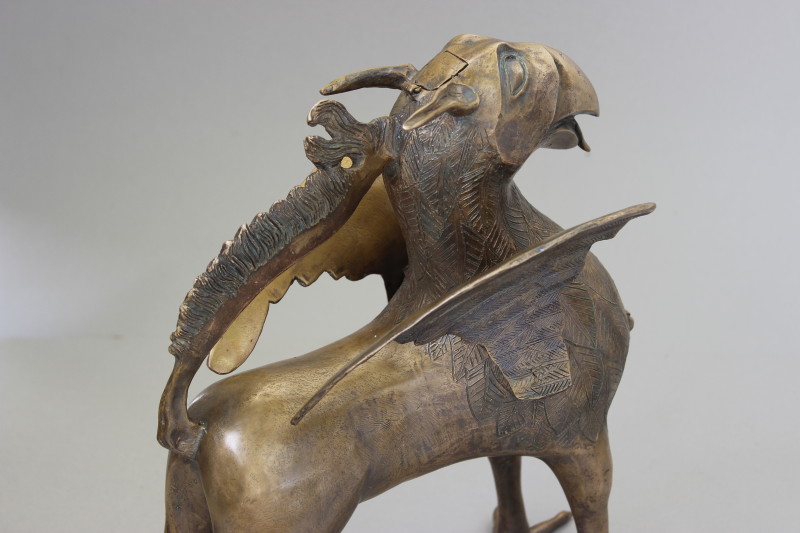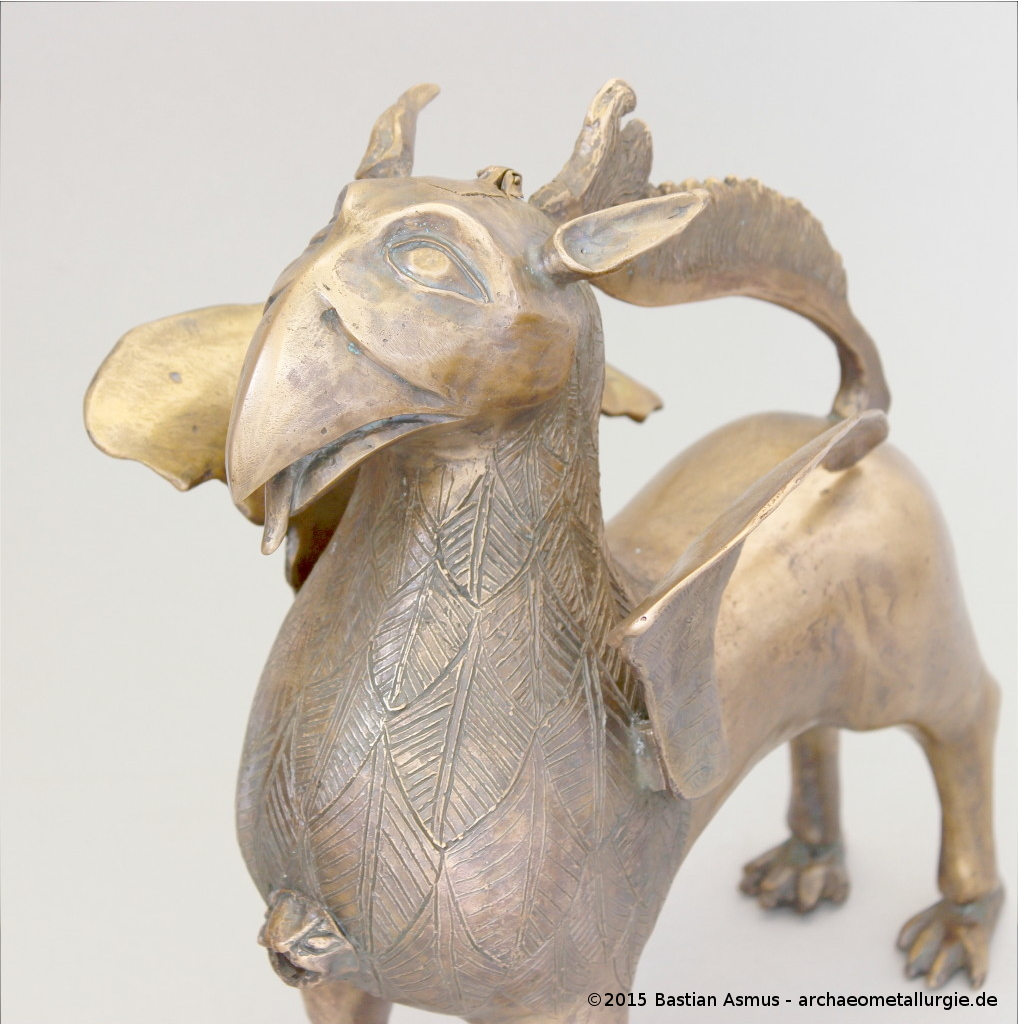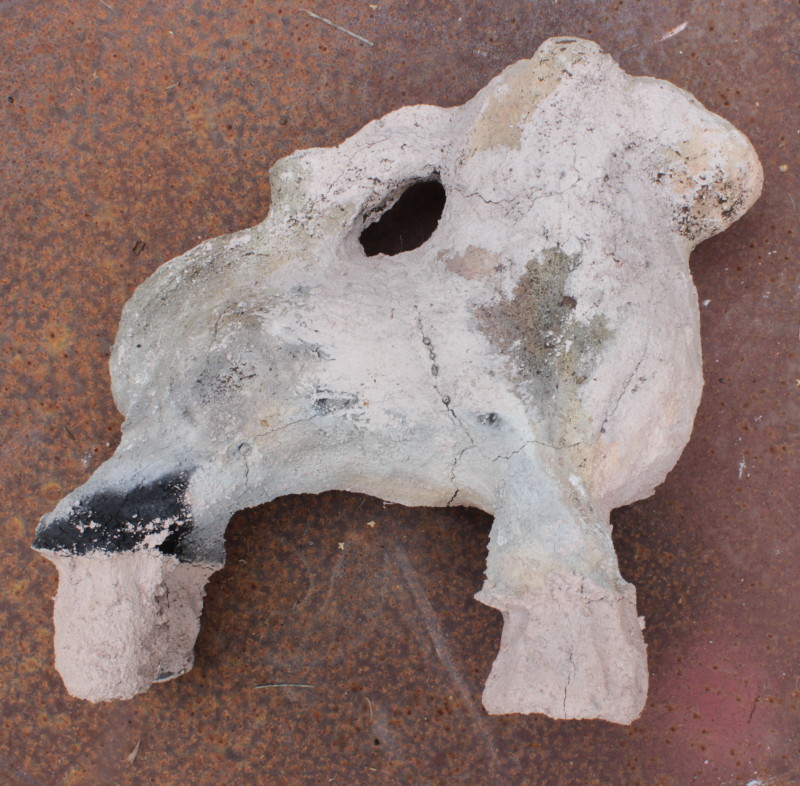May
23
2015
Bastian Asmus

This aquamanile in the form of a knight on horseback was cast in 2015 in Bastian Asmus’ workshop, and leans heavily on an original from the 13th century. It was cast in bronze by the lost wax technique.
Next to lion and griffin aquamanile a knight on horseback was a widely used form of aquamaniles . One of these I made earlier this year and cast it in bronze in my workshop. The original aquamanile is from the 13th century from northern Germany, probably around Hildesheim.
This object displays the impressive skills of the 13th century artists and foundrymen. The arms, legs and stir-ups are modelled full round, which adds quite a bit of complexity to the preparation of the casting mould; especially when we are considering that these moulds were not made like modern investment moulds, but by applying moulding loam to every bit of wax surface. The materials thickness of the bridle or stir-ups is in places less than 2mm in diameter. The knight is not modelled separately but cast in one piece with the horse.
Just as the griffin aquamanile this reconstruction can be seen in the newly opened European Hanseatic League Museum in Lübeck, Germany.
Literature
{1698736:I8UJUA8R}
harvard1
default
asc
0
2726
no comments | tags: Aquamanile, aquamanilia, archaeometallurgy, art, casting, practical archaeometallurgy, Rotgießer, Rothschmied, sculptor | posted in Aquamanile, Archaeometallurgy, Info, Metal casting, practical metallurgy, Reconstructions
May
21
2015
Bastian Asmus

Aquamanile in the form of a griffin. The original is from a 15th century Nuremberg Rotschmied workshop. The pictured aquamanile was modelled by Ragna Asmus and cast by Bastian Asmus.
A griffin aquamanile made some 600 years later
I realise that I have been somewhat negligent over the past three to four months when it comes to writing. I was immersed in the most fascinating and satisfying work in the past four months, however and simply did not have time to write. Within the next few weeks I will post about the 12th to 15th century bronze and brass objects I was commissioned to reconstruct. Let us begin with my favorite piece today: The griffin aquamanile that is now housed in the Metropolitan Museum in New York.
This bronze aquamanile in the form of a griffin was cast in early 2015 and can be viewed from 30 May 2015, the newly established European Hanseatic League Museum. The Griffin was modelled by Ragna Asmus after a griffin aquamanile that was made in Nurmeberg between 1425 and 1450. It is significantly younger than the lion aquamanile I have made two years previously. In the 15th century Nuremberg was a leading centre of the brass and brass-ware production and had surpassed the importance Dinant held in the 12th and 13th centuries. From the 14th century the production of “Dinanderie” shifted from Dinant and the Meuse region to Nuremberg. After Dinant’s destruction in 1466 the metal trades in Nuremberg became an even more important one than Dinant ever was . The numerous professions in the Rotschmiedehandwerk may be seen as an evidence of this upsurge in productivity.
This aquamanile was completely remodelled in bee’s wax and cast in the lost wax process.

Aquamanile in the form of a griffin.
Literature
{1698736:W32WVGS7},{1698736:TIIAPF7E};{1698736:W32WVGS7},{1698736:TIIAPF7E}
harvard1
default
asc
0
2689
no comments | tags: Aquamanile, aquamanilia, casting, Nuremberg, practical archaeometallurgy, Renaissance, Rotgießer, Rothschmied | posted in Aquamanile, Archaeometallurgy, General, Metal casting, practical metallurgy, Reconstructions
Aug
21
2014
Bastian Asmus

The casting of an aquamanile in original medieval technique has been a long term intention of mine. A year ago I made an aquamanile in the form of a lion that dated to the medieval period, however I did not have time to cast that particular aquamanile in a technique that can be considered medieval.- The model however was made with the techniques known to medieval artificers. It was made according to Theophilus Presbyter’s description in his schedula diversarum artium , a 12th century manuscript on artisan’s techniques. Theophilus’ chapter 61 on the making of the cast incense burners provides all the necessary information, with which an informed reader can go ahead an produce a formidable bronze (or any other copper alloy) casting. This information was used to prepare the mould for the casting of this aquamanile. There will be an article shortly on how to make the mould.

Loam mould of the lion aquamanile. The loam mould consists of the same ingredients as medieval moulds.
Casting a medieval aquamanile
The mould was prepared from loam and made three days before the casting. The wax model was molten from the loam mould over embers. The mould was subsequently fired with charcoal. The charcoal was allowed to burn down to the top of the mould and before it was charged again with fresh charcoal. This was repeated three time s, just as Theophilus tells us . The casting was accomplished through the feet; so the mould is placed upside down for the casting. It was cast with a quaternary alloy of copper, zinc, tin and lead. The alloy is CuZn13Sn8Pb2 and was prepared for the casting.
References
{1698736:UT84UXKS};{1698736:UT84UXKS}
apa
default
asc
0
2513
%7B%22status%22%3A%22success%22%2C%22updateneeded%22%3Afalse%2C%22instance%22%3Afalse%2C%22meta%22%3A%7B%22request_last%22%3A1200%2C%22request_next%22%3A50%2C%22used_cache%22%3Atrue%7D%2C%22data%22%3A%5B%7B%22key%22%3A%2226JM8AN2%22%2C%22library%22%3A%7B%22id%22%3A1698736%7D%2C%22meta%22%3A%7B%22creatorSummary%22%3A%22Stephan%20M%5Cu00f6slein%22%2C%22parsedDate%22%3A%222008%22%2C%22numChildren%22%3A1%7D%2C%22bib%22%3A%22%26lt%3Bdiv%20class%3D%26quot%3Bcsl-bib-body%26quot%3B%20style%3D%26quot%3Bline-height%3A%202%3B%20padding-left%3A%202em%3B%20text-indent%3A-2em%3B%26quot%3B%26gt%3B%5Cn%20%20%26lt%3Bdiv%20class%3D%26quot%3Bcsl-entry%26quot%3B%26gt%3BStephan%20M%26%23xF6%3Bslein.%20%282008%29.%20Fr%26%23xFC%3Bhbronzezeitliche%20Depotfunde%20im%20Alpenvorland%20%26%23x2013%3B%20neue%20Befunde%20%28pp.%20109%26%23x2013%3B130%29.%20Presented%20at%20the%20Vortr%26%23xE4%3Bge%20des%2026.%20NIederbayerischen%20Arch%26%23xE4%3Bologentages%2C%20Deggendorf%2C%20Rahden%5C%2FWestfalen.%26lt%3B%5C%2Fdiv%26gt%3B%5Cn%26lt%3B%5C%2Fdiv%26gt%3B%22%2C%22data%22%3A%7B%22itemType%22%3A%22conferencePaper%22%2C%22title%22%3A%22Fr%5Cu00fchbronzezeitliche%20Depotfunde%20im%20Alpenvorland%20%5Cu2013%20neue%20Befunde%22%2C%22creators%22%3A%5B%7B%22creatorType%22%3A%22author%22%2C%22name%22%3A%22Stephan%20M%5Cu00f6slein%22%7D%5D%2C%22abstractNote%22%3A%22%22%2C%22date%22%3A%222008%22%2C%22proceedingsTitle%22%3A%22%22%2C%22conferenceName%22%3A%22Vortr%5Cu00e4ge%20des%2026.%20NIederbayerischen%20Arch%5Cu00e4ologentages%2C%20Deggendorf%22%2C%22language%22%3A%22%22%2C%22DOI%22%3A%22%22%2C%22ISBN%22%3A%22%22%2C%22url%22%3A%22%22%2C%22collections%22%3A%5B%5D%2C%22dateModified%22%3A%222019-05-31T15%3A13%3A30Z%22%7D%7D%2C%7B%22key%22%3A%2246XIMTVI%22%2C%22library%22%3A%7B%22id%22%3A1698736%7D%2C%22meta%22%3A%7B%22creatorSummary%22%3A%22J.J.%20Butler%22%2C%22parsedDate%22%3A%222002%22%2C%22numChildren%22%3A1%7D%2C%22bib%22%3A%22%26lt%3Bdiv%20class%3D%26quot%3Bcsl-bib-body%26quot%3B%20style%3D%26quot%3Bline-height%3A%202%3B%20padding-left%3A%202em%3B%20text-indent%3A-2em%3B%26quot%3B%26gt%3B%5Cn%20%20%26lt%3Bdiv%20class%3D%26quot%3Bcsl-entry%26quot%3B%26gt%3BJ.J.%20Butler.%20%282002%29.%20Ingots%20and%20Insights%3A%20Reflections%20on%20Rings%20and%20Ribs.%20In%20%26lt%3Bi%26gt%3BDie%20Anf%26%23xE4%3Bnge%20der%20Metallurgie%20in%20der%20alten%20Welt%20%3D%3A%20The%20beginnings%20of%20metallurgy%20in%20the%20old%20world%26lt%3B%5C%2Fi%26gt%3B%20%28pp.%20229%26%23x2013%3B243%29.%20Rahden%2C%20Westf%3A%20Verlag%20Marie%20Leidorf.%26lt%3B%5C%2Fdiv%26gt%3B%5Cn%26lt%3B%5C%2Fdiv%26gt%3B%22%2C%22data%22%3A%7B%22itemType%22%3A%22bookSection%22%2C%22title%22%3A%22Ingots%20and%20Insights%3A%20Reflections%20on%20Rings%20and%20Ribs%22%2C%22creators%22%3A%5B%7B%22creatorType%22%3A%22author%22%2C%22name%22%3A%22J.J.%20Butler%22%7D%5D%2C%22abstractNote%22%3A%22%22%2C%22bookTitle%22%3A%22Die%20Anf%5Cu00e4nge%20der%20Metallurgie%20in%20der%20alten%20Welt%20%3D%3A%20The%20beginnings%20of%20metallurgy%20in%20the%20old%20world%22%2C%22date%22%3A%222002%22%2C%22language%22%3A%22ger%20eng%20fre%22%2C%22ISBN%22%3A%22978-3-89646-871-0%22%2C%22url%22%3A%22%22%2C%22collections%22%3A%5B%5D%2C%22dateModified%22%3A%222019-05-31T15%3A09%3A14Z%22%7D%7D%2C%7B%22key%22%3A%22AWUKGXXR%22%2C%22library%22%3A%7B%22id%22%3A1698736%7D%2C%22meta%22%3A%7B%22numChildren%22%3A0%7D%2C%22bib%22%3A%22%26lt%3Bdiv%20class%3D%26quot%3Bcsl-bib-body%26quot%3B%20style%3D%26quot%3Bline-height%3A%202%3B%20padding-left%3A%202em%3B%20text-indent%3A-2em%3B%26quot%3B%26gt%3B%5Cn%20%20%26lt%3Bdiv%20class%3D%26quot%3Bcsl-entry%26quot%3B%26gt%3BIngots%20and%20Insights%3A%20Reflections%20on%20RIngs%20and%20Ribs.%20%28n.d.%29%20%28pp.%20229%26%23x2013%3B243%29.%26lt%3B%5C%2Fdiv%26gt%3B%5Cn%26lt%3B%5C%2Fdiv%26gt%3B%22%2C%22data%22%3A%7B%22itemType%22%3A%22conferencePaper%22%2C%22title%22%3A%22Ingots%20and%20Insights%3A%20Reflections%20on%20RIngs%20and%20Ribs%22%2C%22creators%22%3A%5B%5D%2C%22abstractNote%22%3A%22%22%2C%22date%22%3A%22%22%2C%22proceedingsTitle%22%3A%22%22%2C%22conferenceName%22%3A%22%22%2C%22language%22%3A%22%22%2C%22DOI%22%3A%22%22%2C%22ISBN%22%3A%22%22%2C%22url%22%3A%22%22%2C%22collections%22%3A%5B%5D%2C%22dateModified%22%3A%222019-05-31T15%3A06%3A07Z%22%7D%7D%2C%7B%22key%22%3A%225H87R8UU%22%2C%22library%22%3A%7B%22id%22%3A1698736%7D%2C%22meta%22%3A%7B%22creatorSummary%22%3A%22Dines%22%2C%22parsedDate%22%3A%222010%22%2C%22numChildren%22%3A1%7D%2C%22bib%22%3A%22%26lt%3Bdiv%20class%3D%26quot%3Bcsl-bib-body%26quot%3B%20style%3D%26quot%3Bline-height%3A%202%3B%20padding-left%3A%202em%3B%20text-indent%3A-2em%3B%26quot%3B%26gt%3B%5Cn%20%20%26lt%3Bdiv%20class%3D%26quot%3Bcsl-entry%26quot%3B%26gt%3BDines%2C%20I.%20%282010%29.%20The%20Theophilus%20Manuscript%20Tradition%20Reconsidered%20in%20the%20Light%20of%20New%20Manuscript%20Discoveries.%20In%20M.%20Maui%26%23xE8%3Bge%20%26amp%3B%20H.%20Westerman-Angerhausen%20%28Eds.%29%2C%20%26lt%3Bi%26gt%3BZwischen%20Kunsthandwerk%20und%20Kunst%3A%20Die%20Schedula%20diversarum%20artium%26lt%3B%5C%2Fi%26gt%3B%20%28pp.%203%26%23x2013%3B14%29.%20Berlin%5C%2FBoston%3A%20de%20Gruyter.%26lt%3B%5C%2Fdiv%26gt%3B%5Cn%26lt%3B%5C%2Fdiv%26gt%3B%22%2C%22data%22%3A%7B%22itemType%22%3A%22bookSection%22%2C%22title%22%3A%22The%20Theophilus%20Manuscript%20Tradition%20Reconsidered%20in%20the%20Light%20of%20New%20Manuscript%20Discoveries%22%2C%22creators%22%3A%5B%7B%22creatorType%22%3A%22author%22%2C%22firstName%22%3A%22Ilya%22%2C%22lastName%22%3A%22Dines%22%7D%2C%7B%22creatorType%22%3A%22editor%22%2C%22firstName%22%3A%22Maxime%22%2C%22lastName%22%3A%22Maui%5Cu00e8ge%22%7D%2C%7B%22creatorType%22%3A%22editor%22%2C%22firstName%22%3A%22Hiltrud%22%2C%22lastName%22%3A%22Westerman-Angerhausen%22%7D%5D%2C%22abstractNote%22%3A%22%22%2C%22bookTitle%22%3A%22Zwischen%20Kunsthandwerk%20und%20Kunst%3A%20Die%20Schedula%20diversarum%20artium%22%2C%22date%22%3A%222010%22%2C%22language%22%3A%22%22%2C%22ISBN%22%3A%22%22%2C%22url%22%3A%22%22%2C%22collections%22%3A%5B%5D%2C%22dateModified%22%3A%222019-05-08T07%3A39%3A33Z%22%7D%7D%2C%7B%22key%22%3A%224ICDYHGU%22%2C%22library%22%3A%7B%22id%22%3A1698736%7D%2C%22meta%22%3A%7B%22creatorSummary%22%3A%22Rossi%22%2C%22parsedDate%22%3A%221890%22%2C%22numChildren%22%3A1%7D%2C%22bib%22%3A%22%26lt%3Bdiv%20class%3D%26quot%3Bcsl-bib-body%26quot%3B%20style%3D%26quot%3Bline-height%3A%202%3B%20padding-left%3A%202em%3B%20text-indent%3A-2em%3B%26quot%3B%26gt%3B%5Cn%20%20%26lt%3Bdiv%20class%3D%26quot%3Bcsl-entry%26quot%3B%26gt%3BRossi%2C%20J.-B.%20de.%20%281890%29.%20Cloche%2C%20avec%20inscription%20d%26%23xE9%3Bdicatoire%2C%20du%20VIIIe%20ou%20IXe%20si%26%23xE8%3Bcle%2C%20trouv%26%23xE9%3Be%20%26%23xE0%3B%20Canino.%20%26lt%3Bi%26gt%3BRevue%20de%20l%26%23x2019%3Bart%20Chr%26%23xE9%3Btien%26lt%3B%5C%2Fi%26gt%3B%2C%20%2833%29%2C%201%26%23x2013%3B5.%20Retrieved%20from%20%26lt%3Ba%20class%3D%26%23039%3Bzp-ItemURL%26%23039%3B%20href%3D%26%23039%3Bhttps%3A%5C%2F%5C%2Farchive.org%5C%2Fdetails%5C%2Frevuedelartchr1890lill%26%23039%3B%26gt%3Bhttps%3A%5C%2F%5C%2Farchive.org%5C%2Fdetails%5C%2Frevuedelartchr1890lill%26lt%3B%5C%2Fa%26gt%3B%26lt%3B%5C%2Fdiv%26gt%3B%5Cn%26lt%3B%5C%2Fdiv%26gt%3B%22%2C%22data%22%3A%7B%22itemType%22%3A%22journalArticle%22%2C%22title%22%3A%22Cloche%2C%20avec%20inscription%20d%5Cu00e9dicatoire%2C%20du%20VIIIe%20ou%20IXe%20si%5Cu00e8cle%2C%20trouv%5Cu00e9e%20%5Cu00e0%20Canino%22%2C%22creators%22%3A%5B%7B%22creatorType%22%3A%22author%22%2C%22firstName%22%3A%22J.-Baptista%20de%22%2C%22lastName%22%3A%22Rossi%22%7D%5D%2C%22abstractNote%22%3A%22%22%2C%22date%22%3A%221890%22%2C%22language%22%3A%22%22%2C%22DOI%22%3A%22%22%2C%22ISSN%22%3A%22%22%2C%22url%22%3A%22https%3A%5C%2F%5C%2Farchive.org%5C%2Fdetails%5C%2Frevuedelartchr1890lill%22%2C%22collections%22%3A%5B%5D%2C%22dateModified%22%3A%222019-05-08T07%3A37%3A55Z%22%7D%7D%2C%7B%22key%22%3A%22G52836AQ%22%2C%22library%22%3A%7B%22id%22%3A1698736%7D%2C%22meta%22%3A%7B%22creatorSummary%22%3A%22Drescher%22%2C%22parsedDate%22%3A%221961%22%2C%22numChildren%22%3A1%7D%2C%22bib%22%3A%22%26lt%3Bdiv%20class%3D%26quot%3Bcsl-bib-body%26quot%3B%20style%3D%26quot%3Bline-height%3A%202%3B%20padding-left%3A%202em%3B%20text-indent%3A-2em%3B%26quot%3B%26gt%3B%5Cn%20%20%26lt%3Bdiv%20class%3D%26quot%3Bcsl-entry%26quot%3B%26gt%3BDrescher%2C%20H.%20%281961%29.%20Zwei%20mittelalterliche%20Gie%26%23xDF%3Bereien%20auf%20dem%20Gel%26%23xE4%3Bnde%20des%20ehemaligen%20Hamburger%20Doms.%20%26lt%3Bi%26gt%3BHammaburg%26lt%3B%5C%2Fi%26gt%3B%2C%20%26lt%3Bi%26gt%3BA.%20F.%208%26lt%3B%5C%2Fi%26gt%3B%2C%20107%26%23x2013%3B132.%26lt%3B%5C%2Fdiv%26gt%3B%5Cn%26lt%3B%5C%2Fdiv%26gt%3B%22%2C%22data%22%3A%7B%22itemType%22%3A%22journalArticle%22%2C%22title%22%3A%22Zwei%20mittelalterliche%20Gie%5Cu00dfereien%20auf%20dem%20Gel%5Cu00e4nde%20des%20ehemaligen%20Hamburger%20Doms%22%2C%22creators%22%3A%5B%7B%22creatorType%22%3A%22author%22%2C%22firstName%22%3A%22Hans%22%2C%22lastName%22%3A%22Drescher%22%7D%5D%2C%22abstractNote%22%3A%22%22%2C%22date%22%3A%221961%22%2C%22language%22%3A%22%22%2C%22DOI%22%3A%22%22%2C%22ISSN%22%3A%22%22%2C%22url%22%3A%22%22%2C%22collections%22%3A%5B%5D%2C%22dateModified%22%3A%222019-05-08T07%3A37%3A02Z%22%7D%7D%2C%7B%22key%22%3A%222DF9XDGI%22%2C%22library%22%3A%7B%22id%22%3A1698736%7D%2C%22meta%22%3A%7B%22creatorSummary%22%3A%22Drescher%22%2C%22parsedDate%22%3A%221968%22%2C%22numChildren%22%3A0%7D%2C%22bib%22%3A%22%26lt%3Bdiv%20class%3D%26quot%3Bcsl-bib-body%26quot%3B%20style%3D%26quot%3Bline-height%3A%202%3B%20padding-left%3A%202em%3B%20text-indent%3A-2em%3B%26quot%3B%26gt%3B%5Cn%20%20%26lt%3Bdiv%20class%3D%26quot%3Bcsl-entry%26quot%3B%26gt%3BDrescher%2C%20H.%20%281968%29.%20Mittelalterliche%20Bronzegrapen%20aus%20L%26%23xFC%3Bbeck.%20%26lt%3Bi%26gt%3BDer%20Wagen.%20Ein%20L%26%23xFC%3Bbeckisches%20Jahrbuch%26lt%3B%5C%2Fi%26gt%3B%2C%20164%26%23x2013%3B171.%26lt%3B%5C%2Fdiv%26gt%3B%5Cn%26lt%3B%5C%2Fdiv%26gt%3B%22%2C%22data%22%3A%7B%22itemType%22%3A%22journalArticle%22%2C%22title%22%3A%22Mittelalterliche%20Bronzegrapen%20aus%20L%5Cu00fcbeck%22%2C%22creators%22%3A%5B%7B%22creatorType%22%3A%22author%22%2C%22firstName%22%3A%22Hans%22%2C%22lastName%22%3A%22Drescher%22%7D%5D%2C%22abstractNote%22%3A%22%22%2C%22date%22%3A%221968%22%2C%22language%22%3A%22%22%2C%22DOI%22%3A%22%22%2C%22ISSN%22%3A%22%22%2C%22url%22%3A%22%22%2C%22collections%22%3A%5B%22RI8HAJ3J%22%5D%2C%22dateModified%22%3A%222019-05-08T07%3A36%3A55Z%22%7D%7D%2C%7B%22key%22%3A%228IN9A2H8%22%2C%22library%22%3A%7B%22id%22%3A1698736%7D%2C%22meta%22%3A%7B%22creatorSummary%22%3A%22Drescher%22%2C%22parsedDate%22%3A%221982%22%2C%22numChildren%22%3A0%7D%2C%22bib%22%3A%22%26lt%3Bdiv%20class%3D%26quot%3Bcsl-bib-body%26quot%3B%20style%3D%26quot%3Bline-height%3A%202%3B%20padding-left%3A%202em%3B%20text-indent%3A-2em%3B%26quot%3B%26gt%3B%5Cn%20%20%26lt%3Bdiv%20class%3D%26quot%3Bcsl-entry%26quot%3B%26gt%3BDrescher%2C%20H.%20%281982%29.%20Zu%20den%20bronzenen%20Grapen%20des%2012.-16.%20Jahrhunderts%20aus%20Nordwestdeuschland.%20In%20R.%20Pohl-Weber%20%28Ed.%29%2C%20%26lt%3Bi%26gt%3BAus%20dem%20Alltag%20der%20Mittelalterlichen%20Stadt.%20Handbuch%20zur%20Sonderausstellung%26lt%3B%5C%2Fi%26gt%3B%20%28Vol.%2040%2C%20pp.%20157%26%23x2013%3B174%29.%20Bremen.%26lt%3B%5C%2Fdiv%26gt%3B%5Cn%26lt%3B%5C%2Fdiv%26gt%3B%22%2C%22data%22%3A%7B%22itemType%22%3A%22bookSection%22%2C%22title%22%3A%22Zu%20den%20bronzenen%20Grapen%20des%2012.-16.%20Jahrhunderts%20aus%20Nordwestdeuschland%22%2C%22creators%22%3A%5B%7B%22creatorType%22%3A%22author%22%2C%22firstName%22%3A%22Hans%22%2C%22lastName%22%3A%22Drescher%22%7D%2C%7B%22creatorType%22%3A%22editor%22%2C%22firstName%22%3A%22R.%22%2C%22lastName%22%3A%22Pohl-Weber%22%7D%5D%2C%22abstractNote%22%3A%22%22%2C%22bookTitle%22%3A%22Aus%20dem%20Alltag%20der%20Mittelalterlichen%20Stadt.%20Handbuch%20zur%20Sonderausstellung%22%2C%22date%22%3A%221982%22%2C%22language%22%3A%22%22%2C%22ISBN%22%3A%22%22%2C%22url%22%3A%22%22%2C%22collections%22%3A%5B%22RI8HAJ3J%22%5D%2C%22dateModified%22%3A%222019-05-08T07%3A36%3A43Z%22%7D%7D%2C%7B%22key%22%3A%22FWBHWHWG%22%2C%22library%22%3A%7B%22id%22%3A1698736%7D%2C%22meta%22%3A%7B%22creatorSummary%22%3A%22Drescher%22%2C%22parsedDate%22%3A%221986%22%2C%22numChildren%22%3A0%7D%2C%22bib%22%3A%22%26lt%3Bdiv%20class%3D%26quot%3Bcsl-bib-body%26quot%3B%20style%3D%26quot%3Bline-height%3A%202%3B%20padding-left%3A%202em%3B%20text-indent%3A-2em%3B%26quot%3B%26gt%3B%5Cn%20%20%26lt%3Bdiv%20class%3D%26quot%3Bcsl-entry%26quot%3B%26gt%3BDrescher%2C%20H.%20%281986%29.%20Zum%20Guss%20von%20Bronze%2C%20Messing%20und%20Zinn%20%26%23x201C%3Bum%201200.%26%23x201D%3B%20%26lt%3Bi%26gt%3BZeitschrift%20F%26%23xFC%3Br%20Arch%26%23xE4%3Bologie%20Des%20Mittelalters%26lt%3B%5C%2Fi%26gt%3B%2C%20%26lt%3Bi%26gt%3BBeiheft%204%26lt%3B%5C%2Fi%26gt%3B%2C%20389%26%23x2013%3B405.%26lt%3B%5C%2Fdiv%26gt%3B%5Cn%26lt%3B%5C%2Fdiv%26gt%3B%22%2C%22data%22%3A%7B%22itemType%22%3A%22journalArticle%22%2C%22title%22%3A%22Zum%20Guss%20von%20Bronze%2C%20Messing%20und%20Zinn%20%5C%22um%201200%5C%22%22%2C%22creators%22%3A%5B%7B%22creatorType%22%3A%22author%22%2C%22firstName%22%3A%22Hans%22%2C%22lastName%22%3A%22Drescher%22%7D%5D%2C%22abstractNote%22%3A%22%22%2C%22date%22%3A%221986%22%2C%22language%22%3A%22%22%2C%22DOI%22%3A%22%22%2C%22ISSN%22%3A%22%22%2C%22url%22%3A%22%22%2C%22collections%22%3A%5B%5D%2C%22dateModified%22%3A%222019-05-08T07%3A36%3A34Z%22%7D%7D%2C%7B%22key%22%3A%22P2DXZ99G%22%2C%22library%22%3A%7B%22id%22%3A1698736%7D%2C%22meta%22%3A%7B%22creatorSummary%22%3A%22Drescher%22%2C%22parsedDate%22%3A%221987%22%2C%22numChildren%22%3A0%7D%2C%22bib%22%3A%22%26lt%3Bdiv%20class%3D%26quot%3Bcsl-bib-body%26quot%3B%20style%3D%26quot%3Bline-height%3A%202%3B%20padding-left%3A%202em%3B%20text-indent%3A-2em%3B%26quot%3B%26gt%3B%5Cn%20%20%26lt%3Bdiv%20class%3D%26quot%3Bcsl-entry%26quot%3B%26gt%3BDrescher%2C%20H.%20%281987%29.%20Erg%26%23xE4%3Bnzende%20Bemerkungen%20zum%20Giessereifund%20von%20Bonn-Schwarzrheindorf.%20In%20W.%20Janssen%20%28Ed.%29%2C%20%26lt%3Bi%26gt%3BEine%20mittelalterliche%20Metallgie%26%23xDF%3Berei%20in%20Bonn-Schwarzrheindorf%26lt%3B%5C%2Fi%26gt%3B%20%28Vol.%2027%2C%20pp.%20201%26%23x2013%3B227%29.%26lt%3B%5C%2Fdiv%26gt%3B%5Cn%26lt%3B%5C%2Fdiv%26gt%3B%22%2C%22data%22%3A%7B%22itemType%22%3A%22conferencePaper%22%2C%22title%22%3A%22Erg%5Cu00e4nzende%20Bemerkungen%20zum%20Giessereifund%20von%20Bonn-Schwarzrheindorf%22%2C%22creators%22%3A%5B%7B%22creatorType%22%3A%22author%22%2C%22firstName%22%3A%22Hans%22%2C%22lastName%22%3A%22Drescher%22%7D%2C%7B%22creatorType%22%3A%22editor%22%2C%22firstName%22%3A%22W%22%2C%22lastName%22%3A%22Janssen%22%7D%5D%2C%22abstractNote%22%3A%22%22%2C%22date%22%3A%221987%22%2C%22proceedingsTitle%22%3A%22Eine%20mittelalterliche%20Metallgie%5Cu00dferei%20in%20Bonn-Schwarzrheindorf%22%2C%22conferenceName%22%3A%22%22%2C%22language%22%3A%22%22%2C%22DOI%22%3A%22%22%2C%22ISBN%22%3A%22%22%2C%22url%22%3A%22%22%2C%22collections%22%3A%5B%22RI8HAJ3J%22%5D%2C%22dateModified%22%3A%222019-05-08T07%3A36%3A29Z%22%7D%7D%2C%7B%22key%22%3A%22CPX92XCU%22%2C%22library%22%3A%7B%22id%22%3A1698736%7D%2C%22meta%22%3A%7B%22creatorSummary%22%3A%22Drescher%22%2C%22parsedDate%22%3A%221992%22%2C%22numChildren%22%3A0%7D%2C%22bib%22%3A%22%26lt%3Bdiv%20class%3D%26quot%3Bcsl-bib-body%26quot%3B%20style%3D%26quot%3Bline-height%3A%202%3B%20padding-left%3A%202em%3B%20text-indent%3A-2em%3B%26quot%3B%26gt%3B%5Cn%20%20%26lt%3Bdiv%20class%3D%26quot%3Bcsl-entry%26quot%3B%26gt%3BDrescher%2C%20H.%20%281992%29.%20Glocken%20und%20Glockenguss%20im%2011.%20und%2012.%20Jahrhundert.%20In%20G.%20Waurick%20%26amp%3B%20H.%20W.%20B%26%23xF6%3Bhme%20%28Eds.%29%2C%20%26lt%3Bi%26gt%3BDas%20Reich%20der%20Salier%201024%20-%201125%26%23x202F%3B%3A%20Katalog%20zur%20Ausstellung%20des%20Landes%20Rheinland-Pfalz%3B%20%5BAusstellung%20im%20Historischen%20Museum%20der%20Pfalz%2C%20Speyer%2C%20vom%2023.%20M%26%23xE4%3Brz%20bis%2021.%20Juni%201992%5D%26lt%3B%5C%2Fi%26gt%3B%20%28pp.%20405%26%23x2013%3B414%29.%20Sigmaringen%3A%20Thorbecke.%26lt%3B%5C%2Fdiv%26gt%3B%5Cn%26lt%3B%5C%2Fdiv%26gt%3B%22%2C%22data%22%3A%7B%22itemType%22%3A%22bookSection%22%2C%22title%22%3A%22Glocken%20und%20Glockenguss%20im%2011.%20und%2012.%20Jahrhundert%22%2C%22creators%22%3A%5B%7B%22creatorType%22%3A%22editor%22%2C%22firstName%22%3A%22G%5Cu00f6tz%22%2C%22lastName%22%3A%22Waurick%22%7D%2C%7B%22creatorType%22%3A%22editor%22%2C%22firstName%22%3A%22Horst%20Wolfgang%22%2C%22lastName%22%3A%22B%5Cu00f6hme%22%7D%2C%7B%22creatorType%22%3A%22author%22%2C%22firstName%22%3A%22Hans%22%2C%22lastName%22%3A%22Drescher%22%7D%5D%2C%22abstractNote%22%3A%22%22%2C%22bookTitle%22%3A%22Das%20Reich%20der%20Salier%201024%20-%201125%20%3A%20Katalog%20zur%20Ausstellung%20des%20Landes%20Rheinland-Pfalz%3B%20%5BAusstellung%20im%20Historischen%20Museum%20der%20Pfalz%2C%20Speyer%2C%20vom%2023.%20M%5Cu00e4rz%20bis%2021.%20Juni%201992%5D%22%2C%22date%22%3A%221992%22%2C%22language%22%3A%22%22%2C%22ISBN%22%3A%223-7995-4140-3%22%2C%22url%22%3A%22%22%2C%22collections%22%3A%5B%5D%2C%22dateModified%22%3A%222019-05-08T07%3A36%3A21Z%22%7D%7D%2C%7B%22key%22%3A%226WNC9C3B%22%2C%22library%22%3A%7B%22id%22%3A1698736%7D%2C%22meta%22%3A%7B%22creatorSummary%22%3A%22Drescher%22%2C%22parsedDate%22%3A%221993%22%2C%22numChildren%22%3A0%7D%2C%22bib%22%3A%22%26lt%3Bdiv%20class%3D%26quot%3Bcsl-bib-body%26quot%3B%20style%3D%26quot%3Bline-height%3A%202%3B%20padding-left%3A%202em%3B%20text-indent%3A-2em%3B%26quot%3B%26gt%3B%5Cn%20%20%26lt%3Bdiv%20class%3D%26quot%3Bcsl-entry%26quot%3B%26gt%3BDrescher%2C%20H.%20%281993%29.%20Ein%20Kommentar%20zu%3A%20Gerhard%20Laub%2C%20Zum%20Nachweis%20von%20Rammelsberger%20Kupfer%20in%20Kunstgegenst%26%23xE4%3Bnden%20aus%20Goslar%20und%20in%20anderen%20Metallarbeiten%20des%20Mittelalters.%20In%20%26lt%3Bi%26gt%3BGoslar%20Bergstadt%20-%20Kaiserstadt%20in%20Geschichte%20und%20Kunst%26lt%3B%5C%2Fi%26gt%3B%20%28pp.%20313%26%23x2013%3B316%29.%26lt%3B%5C%2Fdiv%26gt%3B%5Cn%26lt%3B%5C%2Fdiv%26gt%3B%22%2C%22data%22%3A%7B%22itemType%22%3A%22bookSection%22%2C%22title%22%3A%22Ein%20Kommentar%20zu%3A%20Gerhard%20Laub%2C%20Zum%20Nachweis%20von%20Rammelsberger%20Kupfer%20in%20Kunstgegenst%5Cu00e4nden%20aus%20Goslar%20und%20in%20anderen%20Metallarbeiten%20des%20Mittelalters%22%2C%22creators%22%3A%5B%7B%22creatorType%22%3A%22author%22%2C%22firstName%22%3A%22Hans%22%2C%22lastName%22%3A%22Drescher%22%7D%5D%2C%22abstractNote%22%3A%22%22%2C%22bookTitle%22%3A%22Goslar%20Bergstadt%20-%20Kaiserstadt%20in%20Geschichte%20und%20Kunst%22%2C%22date%22%3A%221993%22%2C%22language%22%3A%22%22%2C%22ISBN%22%3A%22%22%2C%22url%22%3A%22%22%2C%22collections%22%3A%5B%22RI8HAJ3J%22%5D%2C%22dateModified%22%3A%222019-05-08T07%3A36%3A16Z%22%7D%7D%2C%7B%22key%22%3A%22RKIKABBU%22%2C%22library%22%3A%7B%22id%22%3A1698736%7D%2C%22meta%22%3A%7B%22creatorSummary%22%3A%22Drescher%22%2C%22parsedDate%22%3A%221993%22%2C%22numChildren%22%3A0%7D%2C%22bib%22%3A%22%26lt%3Bdiv%20class%3D%26quot%3Bcsl-bib-body%26quot%3B%20style%3D%26quot%3Bline-height%3A%202%3B%20padding-left%3A%202em%3B%20text-indent%3A-2em%3B%26quot%3B%26gt%3B%5Cn%20%20%26lt%3Bdiv%20class%3D%26quot%3Bcsl-entry%26quot%3B%26gt%3BDrescher%2C%20H.%20%281993%29.%20Zur%20Herstellungstechnik%20mittelalterlicher%20Bronzen%20aus%20Goslar.%20Der%20Marktbrunnen%2C%20der%20neu%20gefundene%20Bronze%20Vogel%2C%20der%20Greif%20vom%20Kaiserhaus%20und%20der%20Kaiserstuhl.%20In%20%26lt%3Bi%26gt%3BGoslar%20Bergstadt%20-%20Kaiserstadt%20in%20Geschichte%20und%20Kunst%26lt%3B%5C%2Fi%26gt%3B%20%28pp.%20251%26%23x2013%3B301%29.%20G%26%23xF6%3Bttingen.%26lt%3B%5C%2Fdiv%26gt%3B%5Cn%26lt%3B%5C%2Fdiv%26gt%3B%22%2C%22data%22%3A%7B%22itemType%22%3A%22bookSection%22%2C%22title%22%3A%22Zur%20Herstellungstechnik%20mittelalterlicher%20Bronzen%20aus%20Goslar.%20Der%20Marktbrunnen%2C%20der%20neu%20gefundene%20Bronze%20Vogel%2C%20der%20Greif%20vom%20Kaiserhaus%20und%20der%20Kaiserstuhl%22%2C%22creators%22%3A%5B%7B%22creatorType%22%3A%22author%22%2C%22firstName%22%3A%22Hans%22%2C%22lastName%22%3A%22Drescher%22%7D%5D%2C%22abstractNote%22%3A%22%22%2C%22bookTitle%22%3A%22Goslar%20Bergstadt%20-%20Kaiserstadt%20in%20Geschichte%20und%20Kunst%22%2C%22date%22%3A%221993%22%2C%22language%22%3A%22%22%2C%22ISBN%22%3A%22%22%2C%22url%22%3A%22%22%2C%22collections%22%3A%5B%22RI8HAJ3J%22%5D%2C%22dateModified%22%3A%222019-05-08T07%3A36%3A12Z%22%7D%7D%2C%7B%22key%22%3A%22FFUFS9V6%22%2C%22library%22%3A%7B%22id%22%3A1698736%7D%2C%22meta%22%3A%7B%22creatorSummary%22%3A%22Drescher%22%2C%22parsedDate%22%3A%221993%22%2C%22numChildren%22%3A0%7D%2C%22bib%22%3A%22%26lt%3Bdiv%20class%3D%26quot%3Bcsl-bib-body%26quot%3B%20style%3D%26quot%3Bline-height%3A%202%3B%20padding-left%3A%202em%3B%20text-indent%3A-2em%3B%26quot%3B%26gt%3B%5Cn%20%20%26lt%3Bdiv%20class%3D%26quot%3Bcsl-entry%26quot%3B%26gt%3BDrescher%2C%20H.%20%281993%29.%20Zur%20Technik%20berwardinischer%20Silber-%20und%20Bronzeg%26%23xFC%3Bsse.%20In%20%26lt%3Bi%26gt%3BBernward%20von%20Hildesheim%20und%20das%20Zeitalter%20der%20Ottonen%3A%20Katalog%20der%20Ausstellung%2C%20Hildesheim%201993.%20Band%201%26lt%3B%5C%2Fi%26gt%3B%20%28pp.%20337%26%23x2013%3B351%29.%26lt%3B%5C%2Fdiv%26gt%3B%5Cn%26lt%3B%5C%2Fdiv%26gt%3B%22%2C%22data%22%3A%7B%22itemType%22%3A%22bookSection%22%2C%22title%22%3A%22Zur%20Technik%20berwardinischer%20Silber-%20und%20Bronzeg%5Cu00fcsse%22%2C%22creators%22%3A%5B%7B%22creatorType%22%3A%22author%22%2C%22firstName%22%3A%22Hans%22%2C%22lastName%22%3A%22Drescher%22%7D%5D%2C%22abstractNote%22%3A%22%22%2C%22bookTitle%22%3A%22Bernward%20von%20Hildesheim%20und%20das%20Zeitalter%20der%20Ottonen%3A%20Katalog%20der%20Ausstellung%2C%20Hildesheim%201993.%20Band%201%22%2C%22date%22%3A%221993%22%2C%22language%22%3A%22%22%2C%22ISBN%22%3A%22%22%2C%22url%22%3A%22%22%2C%22collections%22%3A%5B%22RI8HAJ3J%22%5D%2C%22dateModified%22%3A%222019-05-08T07%3A36%3A07Z%22%7D%7D%2C%7B%22key%22%3A%22CKJS5RNK%22%2C%22library%22%3A%7B%22id%22%3A1698736%7D%2C%22meta%22%3A%7B%22creatorSummary%22%3A%22Drescher%22%2C%22parsedDate%22%3A%221995%22%2C%22numChildren%22%3A1%7D%2C%22bib%22%3A%22%26lt%3Bdiv%20class%3D%26quot%3Bcsl-bib-body%26quot%3B%20style%3D%26quot%3Bline-height%3A%202%3B%20padding-left%3A%202em%3B%20text-indent%3A-2em%3B%26quot%3B%26gt%3B%5Cn%20%20%26lt%3Bdiv%20class%3D%26quot%3Bcsl-entry%26quot%3B%26gt%3BDrescher%2C%20H.%20%281995%29.%20Gie%26%23xDF%3Bformen%20fr%26%23xFC%3Bher%20Glocken%20aus%20Mainz.%20%26lt%3Bi%26gt%3BMainzer%20Zeitschrift%26lt%3B%5C%2Fi%26gt%3B%2C%20%26lt%3Bi%26gt%3B90%5C%2F91%26lt%3B%5C%2Fi%26gt%3B%2C%20183%26%23x2013%3B225.%26lt%3B%5C%2Fdiv%26gt%3B%5Cn%26lt%3B%5C%2Fdiv%26gt%3B%22%2C%22data%22%3A%7B%22itemType%22%3A%22journalArticle%22%2C%22title%22%3A%22Gie%5Cu00dfformen%20fr%5Cu00fcher%20Glocken%20aus%20Mainz%22%2C%22creators%22%3A%5B%7B%22creatorType%22%3A%22author%22%2C%22firstName%22%3A%22Hans%22%2C%22lastName%22%3A%22Drescher%22%7D%5D%2C%22abstractNote%22%3A%22%22%2C%22date%22%3A%221995%5C%2F96%22%2C%22language%22%3A%22%22%2C%22DOI%22%3A%22%22%2C%22ISSN%22%3A%22%22%2C%22url%22%3A%22%22%2C%22collections%22%3A%5B%5D%2C%22dateModified%22%3A%222019-05-08T07%3A36%3A02Z%22%7D%7D%2C%7B%22key%22%3A%22JNZVJZ6N%22%2C%22library%22%3A%7B%22id%22%3A1698736%7D%2C%22meta%22%3A%7B%22creatorSummary%22%3A%22Drescher%22%2C%22parsedDate%22%3A%221999%22%2C%22numChildren%22%3A0%7D%2C%22bib%22%3A%22%26lt%3Bdiv%20class%3D%26quot%3Bcsl-bib-body%26quot%3B%20style%3D%26quot%3Bline-height%3A%202%3B%20padding-left%3A%202em%3B%20text-indent%3A-2em%3B%26quot%3B%26gt%3B%5Cn%20%20%26lt%3Bdiv%20class%3D%26quot%3Bcsl-entry%26quot%3B%26gt%3BDrescher%2C%20H.%20%281999%29.%20Die%20Glocken%20der%20karolingerzeitlichen%20Stiftdkirche%20bei%20Vreden%2C%20Kreis%20Ahaus.%20In%20C.%20Stiegemann%20%26amp%3B%20M.%20Wemhoff%20%28Eds.%29%2C%20%26lt%3Bi%26gt%3B799%2C%20Kunst%20und%20Kultur%20der%20Karolingerzeit%3A%20Karl%20der%20Grosse%20und%20Papst%20Leo%20III.%20in%20Paderborn%3A%20Katalog%20der%20Ausstellung%2C%20Paderborn%201999%26lt%3B%5C%2Fi%26gt%3B%20%28pp.%20356%26%23x2013%3B364%29.%20Mainz%3A%20P.%20von%20Zabern.%26lt%3B%5C%2Fdiv%26gt%3B%5Cn%26lt%3B%5C%2Fdiv%26gt%3B%22%2C%22data%22%3A%7B%22itemType%22%3A%22bookSection%22%2C%22title%22%3A%22Die%20Glocken%20der%20karolingerzeitlichen%20Stiftdkirche%20bei%20Vreden%2C%20Kreis%20Ahaus%22%2C%22creators%22%3A%5B%7B%22creatorType%22%3A%22editor%22%2C%22firstName%22%3A%22Christoph%22%2C%22lastName%22%3A%22Stiegemann%22%7D%2C%7B%22creatorType%22%3A%22editor%22%2C%22firstName%22%3A%22Matthias%22%2C%22lastName%22%3A%22Wemhoff%22%7D%2C%7B%22creatorType%22%3A%22author%22%2C%22firstName%22%3A%22Hans%22%2C%22lastName%22%3A%22Drescher%22%7D%5D%2C%22abstractNote%22%3A%22%22%2C%22bookTitle%22%3A%22799%2C%20Kunst%20und%20Kultur%20der%20Karolingerzeit%3A%20Karl%20der%20Grosse%20und%20Papst%20Leo%20III.%20in%20Paderborn%3A%20Katalog%20der%20Ausstellung%2C%20Paderborn%201999%22%2C%22date%22%3A%221999%22%2C%22language%22%3A%22%22%2C%22ISBN%22%3A%22978-3-8053-2456-4%20978-3-8053-2460-1%22%2C%22url%22%3A%22%22%2C%22collections%22%3A%5B%5D%2C%22dateModified%22%3A%222019-05-08T07%3A35%3A56Z%22%7D%7D%2C%7B%22key%22%3A%227ZV3MN3T%22%2C%22library%22%3A%7B%22id%22%3A1698736%7D%2C%22meta%22%3A%7B%22creatorSummary%22%3A%22Janssen%22%2C%22parsedDate%22%3A%221987%22%2C%22numChildren%22%3A0%7D%2C%22bib%22%3A%22%26lt%3Bdiv%20class%3D%26quot%3Bcsl-bib-body%26quot%3B%20style%3D%26quot%3Bline-height%3A%202%3B%20padding-left%3A%202em%3B%20text-indent%3A-2em%3B%26quot%3B%26gt%3B%5Cn%20%20%26lt%3Bdiv%20class%3D%26quot%3Bcsl-entry%26quot%3B%26gt%3BJanssen%2C%20W.%20%281987%29.%20Eine%20mittelalterliche%20Metallgie%26%23xDF%3Berei%20in%20Bonn-%20Schwarzrheindorf.%20Mit%20Beitr%26%23xE4%3Bgen%20von%20Hans%20Drescher%2C%20Christoph%20J.%20Raub%20und%20Josef%20Riederer.%20In%20%26lt%3Bi%26gt%3BBeitr%26%23xE4%3Bge%20zur%20Arch%26%23xE4%3Bologie%20des%20Rheinlandes.%20Rheinische%20Ausgrabungen%26lt%3B%5C%2Fi%26gt%3B%20%28Vol.%2027%2C%20pp.%20135%26%23x2013%3B235%29.%20K%26%23xF6%3Bln.%26lt%3B%5C%2Fdiv%26gt%3B%5Cn%26lt%3B%5C%2Fdiv%26gt%3B%22%2C%22data%22%3A%7B%22itemType%22%3A%22bookSection%22%2C%22title%22%3A%22Eine%20mittelalterliche%20Metallgie%5Cu00dferei%20in%20Bonn-%20Schwarzrheindorf.%20Mit%20Beitr%5Cu00e4gen%20von%20Hans%20Drescher%2C%20Christoph%20J.%20Raub%20und%20Josef%20Riederer.%22%2C%22creators%22%3A%5B%7B%22creatorType%22%3A%22author%22%2C%22firstName%22%3A%22Walter%22%2C%22lastName%22%3A%22Janssen%22%7D%5D%2C%22abstractNote%22%3A%22%22%2C%22bookTitle%22%3A%22Beitr%5Cu00e4ge%20zur%20Arch%5Cu00e4ologie%20des%20Rheinlandes.%20Rheinische%20Ausgrabungen%22%2C%22date%22%3A%221987%22%2C%22language%22%3A%22%22%2C%22ISBN%22%3A%22%22%2C%22url%22%3A%22%22%2C%22collections%22%3A%5B%5D%2C%22dateModified%22%3A%222019-05-08T07%3A35%3A49Z%22%7D%7D%2C%7B%22key%22%3A%22EXBIW7AU%22%2C%22library%22%3A%7B%22id%22%3A1698736%7D%2C%22meta%22%3A%7B%22creatorSummary%22%3A%22Haiduck%22%2C%22parsedDate%22%3A%221997%22%2C%22numChildren%22%3A1%7D%2C%22bib%22%3A%22%26lt%3Bdiv%20class%3D%26quot%3Bcsl-bib-body%26quot%3B%20style%3D%26quot%3Bline-height%3A%202%3B%20padding-left%3A%202em%3B%20text-indent%3A-2em%3B%26quot%3B%26gt%3B%5Cn%20%20%26lt%3Bdiv%20class%3D%26quot%3Bcsl-entry%26quot%3B%26gt%3BHaiduck%2C%20H.%20%281997%29.%20Die%20mittelalterliche%20Gussform%20eines%20Taufkessels%20aus%20der%20Kirche%20von%20Cappel%20%28Kreis%20Cuxhaven%29.%20%26lt%3Bi%26gt%3BZeitschrift%20F%26%23xFC%3Br%20Arch%26%23xE4%3Bologie%20Des%20Mittelalters%26lt%3B%5C%2Fi%26gt%3B%2C%20%26lt%3Bi%26gt%3B25%5C%2F26%26lt%3B%5C%2Fi%26gt%3B%2C%2087%26%23x2013%3B105.%26lt%3B%5C%2Fdiv%26gt%3B%5Cn%26lt%3B%5C%2Fdiv%26gt%3B%22%2C%22data%22%3A%7B%22itemType%22%3A%22journalArticle%22%2C%22title%22%3A%22Die%20mittelalterliche%20Gussform%20eines%20Taufkessels%20aus%20der%20Kirche%20von%20Cappel%20%28Kreis%20Cuxhaven%29%22%2C%22creators%22%3A%5B%7B%22creatorType%22%3A%22author%22%2C%22firstName%22%3A%22H.%22%2C%22lastName%22%3A%22Haiduck%22%7D%5D%2C%22abstractNote%22%3A%22%22%2C%22date%22%3A%221997%5C%2F98%22%2C%22language%22%3A%22%22%2C%22DOI%22%3A%22%22%2C%22ISSN%22%3A%22%22%2C%22url%22%3A%22%22%2C%22collections%22%3A%5B%5D%2C%22dateModified%22%3A%222019-05-08T07%3A35%3A16Z%22%7D%7D%2C%7B%22key%22%3A%22WZJGGXE6%22%2C%22library%22%3A%7B%22id%22%3A1698736%7D%2C%22meta%22%3A%7B%22creatorSummary%22%3A%22Sugaki%20et%20al.%22%2C%22parsedDate%22%3A%221981%22%2C%22numChildren%22%3A0%7D%2C%22bib%22%3A%22%26lt%3Bdiv%20class%3D%26quot%3Bcsl-bib-body%26quot%3B%20style%3D%26quot%3Bline-height%3A%202%3B%20padding-left%3A%202em%3B%20text-indent%3A-2em%3B%26quot%3B%26gt%3B%5Cn%20%20%26lt%3Bdiv%20class%3D%26quot%3Bcsl-entry%26quot%3B%26gt%3BSugaki%2C%20A.%2C%20Shima%2C%20H.%2C%20Kitakaze%2C%20A.%2C%20%26amp%3B%20Mizota%2C%20T.%20%281981%29.%20Hydrothermal%20synthesis%20of%20nukundamite%20and%20its%20crystal%20structure.%20%26lt%3Bi%26gt%3BAmerican%20Mineralogist%26lt%3B%5C%2Fi%26gt%3B%2C%20%26lt%3Bi%26gt%3B66%26lt%3B%5C%2Fi%26gt%3B%2C%20398%26%23x2013%3B402.%26lt%3B%5C%2Fdiv%26gt%3B%5Cn%26lt%3B%5C%2Fdiv%26gt%3B%22%2C%22data%22%3A%7B%22itemType%22%3A%22journalArticle%22%2C%22title%22%3A%22Hydrothermal%20synthesis%20of%20nukundamite%20and%20its%20crystal%20structure%22%2C%22creators%22%3A%5B%7B%22creatorType%22%3A%22author%22%2C%22firstName%22%3A%22A.%22%2C%22lastName%22%3A%22Sugaki%22%7D%2C%7B%22creatorType%22%3A%22author%22%2C%22firstName%22%3A%22H.%22%2C%22lastName%22%3A%22Shima%22%7D%2C%7B%22creatorType%22%3A%22author%22%2C%22firstName%22%3A%22A.%22%2C%22lastName%22%3A%22Kitakaze%22%7D%2C%7B%22creatorType%22%3A%22author%22%2C%22firstName%22%3A%22T.%22%2C%22lastName%22%3A%22Mizota%22%7D%5D%2C%22abstractNote%22%3A%22%22%2C%22date%22%3A%221981%22%2C%22language%22%3A%22%22%2C%22DOI%22%3A%22%22%2C%22ISSN%22%3A%22%22%2C%22url%22%3A%22%22%2C%22collections%22%3A%5B%22RI8HAJ3J%22%5D%2C%22dateModified%22%3A%222019-05-08T07%3A34%3A06Z%22%7D%7D%2C%7B%22key%22%3A%22MIQUCSWR%22%2C%22library%22%3A%7B%22id%22%3A1698736%7D%2C%22meta%22%3A%7B%22creatorSummary%22%3A%22Suhling%22%2C%22parsedDate%22%3A%221997%22%2C%22numChildren%22%3A0%7D%2C%22bib%22%3A%22%26lt%3Bdiv%20class%3D%26quot%3Bcsl-bib-body%26quot%3B%20style%3D%26quot%3Bline-height%3A%202%3B%20padding-left%3A%202em%3B%20text-indent%3A-2em%3B%26quot%3B%26gt%3B%5Cn%20%20%26lt%3Bdiv%20class%3D%26quot%3Bcsl-entry%26quot%3B%26gt%3BSuhling%2C%20L.%20%281997%29.%20Kupfer-%20und%20Silberh%26%23xFC%3Btten%20in%20Buchillustrationen%20der%20fr%26%23xFC%3Bhen%20Neuzeit.%20%26lt%3Bi%26gt%3BBerichte%20Der%20Geologischen%20Bundesanstalt%26lt%3B%5C%2Fi%26gt%3B%2C%20%26lt%3Bi%26gt%3B41%26lt%3B%5C%2Fi%26gt%3B%2C%20219%26%23x2013%3B231.%26lt%3B%5C%2Fdiv%26gt%3B%5Cn%26lt%3B%5C%2Fdiv%26gt%3B%22%2C%22data%22%3A%7B%22itemType%22%3A%22journalArticle%22%2C%22title%22%3A%22Kupfer-%20und%20Silberh%5Cu00fctten%20in%20Buchillustrationen%20der%20fr%5Cu00fchen%20Neuzeit%22%2C%22creators%22%3A%5B%7B%22creatorType%22%3A%22author%22%2C%22firstName%22%3A%22Lothar%22%2C%22lastName%22%3A%22Suhling%22%7D%5D%2C%22abstractNote%22%3A%22%22%2C%22date%22%3A%221997%22%2C%22language%22%3A%22%22%2C%22DOI%22%3A%22%22%2C%22ISSN%22%3A%22%22%2C%22url%22%3A%22%22%2C%22collections%22%3A%5B%22RI8HAJ3J%22%5D%2C%22dateModified%22%3A%222019-05-08T07%3A33%3A49Z%22%7D%7D%2C%7B%22key%22%3A%22DGKI7EUF%22%2C%22library%22%3A%7B%22id%22%3A1698736%7D%2C%22meta%22%3A%7B%22creatorSummary%22%3A%22Telle%20and%20Th%5Cu00f6nni%5Cu00dfen%22%2C%22parsedDate%22%3A%222006%22%2C%22numChildren%22%3A0%7D%2C%22bib%22%3A%22%26lt%3Bdiv%20class%3D%26quot%3Bcsl-bib-body%26quot%3B%20style%3D%26quot%3Bline-height%3A%202%3B%20padding-left%3A%202em%3B%20text-indent%3A-2em%3B%26quot%3B%26gt%3B%5Cn%20%20%26lt%3Bdiv%20class%3D%26quot%3Bcsl-entry%26quot%3B%26gt%3BTelle%2C%20R.%2C%20%26amp%3B%20Th%26%23xF6%3Bnni%26%23xDF%3Ben%2C%20M.%20%282006%29.%20Pr%26%23xE4%3Bhistorische%20feuerfeste%20Werkstoffe%20und%20ihre%20Weiterentwicklung%20in%20keltischer%20und%20r%26%23xF6%3Bmischer%20Zeit.%20%26lt%3Bi%26gt%3BPr%26%23xE4%3Bhistorische%20Feuerfeste%20Werkstoffe%20Und%20Ihre%20Weiterentwicklung%20in%20Keltischer%20Und%20R%26%23xF6%3Bmischer%20Zeit%26lt%3B%5C%2Fi%26gt%3B%2C%20%26lt%3Bi%26gt%3B43%26lt%3B%5C%2Fi%26gt%3B%282%29%2C%2055%26%23x2013%3B87.%26lt%3B%5C%2Fdiv%26gt%3B%5Cn%26lt%3B%5C%2Fdiv%26gt%3B%22%2C%22data%22%3A%7B%22itemType%22%3A%22journalArticle%22%2C%22title%22%3A%22Pr%5Cu00e4historische%20feuerfeste%20Werkstoffe%20und%20ihre%20Weiterentwicklung%20in%20keltischer%20und%20r%5Cu00f6mischer%20Zeit%22%2C%22creators%22%3A%5B%7B%22creatorType%22%3A%22author%22%2C%22firstName%22%3A%22Rainer%22%2C%22lastName%22%3A%22Telle%22%7D%2C%7B%22creatorType%22%3A%22author%22%2C%22firstName%22%3A%22Martina%22%2C%22lastName%22%3A%22Th%5Cu00f6nni%5Cu00dfen%22%7D%5D%2C%22abstractNote%22%3A%22%22%2C%22date%22%3A%222006%22%2C%22language%22%3A%22%22%2C%22DOI%22%3A%22%22%2C%22ISSN%22%3A%22%22%2C%22url%22%3A%22%22%2C%22collections%22%3A%5B%22RI8HAJ3J%22%5D%2C%22dateModified%22%3A%222019-05-08T07%3A33%3A27Z%22%7D%7D%2C%7B%22key%22%3A%22M7EWRSMR%22%2C%22library%22%3A%7B%22id%22%3A1698736%7D%2C%22meta%22%3A%7B%22creatorSummary%22%3A%22Thies%22%2C%22parsedDate%22%3A%221993%22%2C%22numChildren%22%3A0%7D%2C%22bib%22%3A%22%26lt%3Bdiv%20class%3D%26quot%3Bcsl-bib-body%26quot%3B%20style%3D%26quot%3Bline-height%3A%202%3B%20padding-left%3A%202em%3B%20text-indent%3A-2em%3B%26quot%3B%26gt%3B%5Cn%20%20%26lt%3Bdiv%20class%3D%26quot%3Bcsl-entry%26quot%3B%26gt%3BThies%2C%20H.%20%281993%29.%20Goslar%20und%20die%20fr%26%23xFC%3Bhen%20nieders%26%23xE4%3Bchsichen%20Geb%26%23xE4%3Bude.%20In%20%26lt%3Bi%26gt%3BGoslar%20Bergstadt%20-%20Kaiserstadt%20in%20Geschichte%20und%20Kunst%26lt%3B%5C%2Fi%26gt%3B%20%28pp.%2095%26%23x2013%3B113%29.%26lt%3B%5C%2Fdiv%26gt%3B%5Cn%26lt%3B%5C%2Fdiv%26gt%3B%22%2C%22data%22%3A%7B%22itemType%22%3A%22bookSection%22%2C%22title%22%3A%22Goslar%20und%20die%20fr%5Cu00fchen%20nieders%5Cu00e4chsichen%20Geb%5Cu00e4ude%22%2C%22creators%22%3A%5B%7B%22creatorType%22%3A%22author%22%2C%22firstName%22%3A%22Harmen%22%2C%22lastName%22%3A%22Thies%22%7D%5D%2C%22abstractNote%22%3A%22%22%2C%22bookTitle%22%3A%22Goslar%20Bergstadt%20-%20Kaiserstadt%20in%20Geschichte%20und%20Kunst%22%2C%22date%22%3A%221993%22%2C%22language%22%3A%22%22%2C%22ISBN%22%3A%22%22%2C%22url%22%3A%22%22%2C%22collections%22%3A%5B%22RI8HAJ3J%22%5D%2C%22dateModified%22%3A%222019-05-08T07%3A33%3A19Z%22%7D%7D%2C%7B%22key%22%3A%2252VEN5A4%22%2C%22library%22%3A%7B%22id%22%3A1698736%7D%2C%22meta%22%3A%7B%22creatorSummary%22%3A%22Tholl%22%2C%22parsedDate%22%3A%222001%22%2C%22numChildren%22%3A0%7D%2C%22bib%22%3A%22%26lt%3Bdiv%20class%3D%26quot%3Bcsl-bib-body%26quot%3B%20style%3D%26quot%3Bline-height%3A%202%3B%20padding-left%3A%202em%3B%20text-indent%3A-2em%3B%26quot%3B%26gt%3B%5Cn%20%20%26lt%3Bdiv%20class%3D%26quot%3Bcsl-entry%26quot%3B%26gt%3BTholl%2C%20S.%20%282001%29.%20Macht%20und%20Pracht.%20In%20%26lt%3Bi%26gt%3BDer%20Rammelsberg.%20Tausend%20Jahre%20Mensch%20%26%23x2013%3B%20Natur%20%26%23x2013%3B%20Technik.%20Band%202%26lt%3B%5C%2Fi%26gt%3B%20%28pp.%20302%26%23x2013%3B315%29.%26lt%3B%5C%2Fdiv%26gt%3B%5Cn%26lt%3B%5C%2Fdiv%26gt%3B%22%2C%22data%22%3A%7B%22itemType%22%3A%22bookSection%22%2C%22title%22%3A%22Macht%20und%20Pracht%22%2C%22creators%22%3A%5B%7B%22creatorType%22%3A%22author%22%2C%22firstName%22%3A%22Stefan%22%2C%22lastName%22%3A%22Tholl%22%7D%5D%2C%22abstractNote%22%3A%22%22%2C%22bookTitle%22%3A%22Der%20Rammelsberg.%20Tausend%20Jahre%20Mensch%20%5Cu2013%20Natur%20%5Cu2013%20Technik.%20Band%202%22%2C%22date%22%3A%222001%22%2C%22language%22%3A%22%22%2C%22ISBN%22%3A%22%22%2C%22url%22%3A%22%22%2C%22collections%22%3A%5B%22RI8HAJ3J%22%5D%2C%22dateModified%22%3A%222019-05-08T07%3A33%3A13Z%22%7D%7D%2C%7B%22key%22%3A%22EHWFFTXG%22%2C%22library%22%3A%7B%22id%22%3A1698736%7D%2C%22meta%22%3A%7B%22creatorSummary%22%3A%22Thornton%20et%20al.%22%2C%22parsedDate%22%3A%222009%22%2C%22numChildren%22%3A0%7D%2C%22bib%22%3A%22%26lt%3Bdiv%20class%3D%26quot%3Bcsl-bib-body%26quot%3B%20style%3D%26quot%3Bline-height%3A%202%3B%20padding-left%3A%202em%3B%20text-indent%3A-2em%3B%26quot%3B%26gt%3B%5Cn%20%20%26lt%3Bdiv%20class%3D%26quot%3Bcsl-entry%26quot%3B%26gt%3BThornton%2C%20C.%2C%20Rehren%2C%20T.%2C%20%26amp%3B%20Pigott%2C%20V.%20%282009%29.%20The%20Production%20of%20Speiss%20%28Iron%20Arsenide%29%20during%20the%20Early%20Bronze%20Age%20in%20Iran.%20%26lt%3Bi%26gt%3BJournal%20of%20Archaeological%20Science%26lt%3B%5C%2Fi%26gt%3B%2C%20%26lt%3Bi%26gt%3B36%26lt%3B%5C%2Fi%26gt%3B%282%29%2C%20308%26%23x2013%3B316.%26lt%3B%5C%2Fdiv%26gt%3B%5Cn%26lt%3B%5C%2Fdiv%26gt%3B%22%2C%22data%22%3A%7B%22itemType%22%3A%22journalArticle%22%2C%22title%22%3A%22The%20Production%20of%20Speiss%20%28Iron%20Arsenide%29%20during%20the%20Early%20Bronze%20Age%20in%20Iran%22%2C%22creators%22%3A%5B%7B%22creatorType%22%3A%22author%22%2C%22firstName%22%3A%22Chris%22%2C%22lastName%22%3A%22Thornton%22%7D%2C%7B%22creatorType%22%3A%22author%22%2C%22firstName%22%3A%22Thilo%22%2C%22lastName%22%3A%22Rehren%22%7D%2C%7B%22creatorType%22%3A%22author%22%2C%22firstName%22%3A%22Vincent%22%2C%22lastName%22%3A%22Pigott%22%7D%5D%2C%22abstractNote%22%3A%22%22%2C%22date%22%3A%222009%22%2C%22language%22%3A%22%22%2C%22DOI%22%3A%22%22%2C%22ISSN%22%3A%22%22%2C%22url%22%3A%22%22%2C%22collections%22%3A%5B%22RI8HAJ3J%22%5D%2C%22dateModified%22%3A%222019-05-08T07%3A33%3A04Z%22%7D%7D%2C%7B%22key%22%3A%22V2HRQMZK%22%2C%22library%22%3A%7B%22id%22%3A1698736%7D%2C%22meta%22%3A%7B%22creatorSummary%22%3A%22Thornton%20and%20Giardino%22%2C%22parsedDate%22%3A%222012%22%2C%22numChildren%22%3A1%7D%2C%22bib%22%3A%22%26lt%3Bdiv%20class%3D%26quot%3Bcsl-bib-body%26quot%3B%20style%3D%26quot%3Bline-height%3A%202%3B%20padding-left%3A%202em%3B%20text-indent%3A-2em%3B%26quot%3B%26gt%3B%5Cn%20%20%26lt%3Bdiv%20class%3D%26quot%3Bcsl-entry%26quot%3B%26gt%3BThornton%2C%20C.%20P.%2C%20%26amp%3B%20Giardino%2C%20C.%20%282012%29.%20Serge%20Cleuziou%20and%20the%20%26%23x201C%3BTin%20Problem.%26%23x201D%3B%20In%20%26lt%3Bi%26gt%3BAux%20Marges%20de%20l%26%23x2019%3Barcheologie%3A%20Hommage%20a%20Serge%20Cleuziou%26lt%3B%5C%2Fi%26gt%3B%20%28pp.%20253%26%23x2013%3B260%29.%20Paris%3A%20De%20Boccard.%26lt%3B%5C%2Fdiv%26gt%3B%5Cn%26lt%3B%5C%2Fdiv%26gt%3B%22%2C%22data%22%3A%7B%22itemType%22%3A%22bookSection%22%2C%22title%22%3A%22Serge%20Cleuziou%20and%20the%20%27Tin%20Problem%27%22%2C%22creators%22%3A%5B%7B%22creatorType%22%3A%22author%22%2C%22firstName%22%3A%22Chrisoph%20Peter%22%2C%22lastName%22%3A%22Thornton%22%7D%2C%7B%22creatorType%22%3A%22author%22%2C%22firstName%22%3A%22Claudio%22%2C%22lastName%22%3A%22Giardino%22%7D%5D%2C%22abstractNote%22%3A%22%22%2C%22bookTitle%22%3A%22Aux%20Marges%20de%20l%27archeologie%3A%20Hommage%20a%20Serge%20Cleuziou%22%2C%22date%22%3A%222012%22%2C%22language%22%3A%22%22%2C%22ISBN%22%3A%22%22%2C%22url%22%3A%22%22%2C%22collections%22%3A%5B%22RI8HAJ3J%22%5D%2C%22dateModified%22%3A%222019-05-08T07%3A32%3A59Z%22%7D%7D%2C%7B%22key%22%3A%22ANUMU228%22%2C%22library%22%3A%7B%22id%22%3A1698736%7D%2C%22meta%22%3A%7B%22creatorSummary%22%3A%22Thornton%22%2C%22parsedDate%22%3A%222009%22%2C%22numChildren%22%3A1%7D%2C%22bib%22%3A%22%26lt%3Bdiv%20class%3D%26quot%3Bcsl-bib-body%26quot%3B%20style%3D%26quot%3Bline-height%3A%202%3B%20padding-left%3A%202em%3B%20text-indent%3A-2em%3B%26quot%3B%26gt%3B%5Cn%20%20%26lt%3Bdiv%20class%3D%26quot%3Bcsl-entry%26quot%3B%26gt%3BThornton%2C%20C.%20%282009%29.%20The%20Emergence%20of%20Complex%20Metallurgy%20on%20the%20Iranian%20Plateau%3A%20Escaping%20the%20Levantine%20Paradigm.%20%26lt%3Bi%26gt%3BJournal%20of%20World%20Prehistory%26lt%3B%5C%2Fi%26gt%3B%2C%20%26lt%3Bi%26gt%3B22%26lt%3B%5C%2Fi%26gt%3B%283%29%2C%20301%26%23x2013%3B327.%20%26lt%3Ba%20class%3D%26%23039%3Bzp-DOIURL%26%23039%3B%20href%3D%26%23039%3Bhttps%3A%5C%2F%5C%2Fdoi.org%5C%2F10.1007%5C%2Fs10963-009-9019-1%26%23039%3B%26gt%3Bhttps%3A%5C%2F%5C%2Fdoi.org%5C%2F10.1007%5C%2Fs10963-009-9019-1%26lt%3B%5C%2Fa%26gt%3B%26lt%3B%5C%2Fdiv%26gt%3B%5Cn%26lt%3B%5C%2Fdiv%26gt%3B%22%2C%22data%22%3A%7B%22itemType%22%3A%22journalArticle%22%2C%22title%22%3A%22The%20Emergence%20of%20Complex%20Metallurgy%20on%20the%20Iranian%20Plateau%3A%20Escaping%20the%20Levantine%20Paradigm%22%2C%22creators%22%3A%5B%7B%22creatorType%22%3A%22author%22%2C%22firstName%22%3A%22Christopher%22%2C%22lastName%22%3A%22Thornton%22%7D%5D%2C%22abstractNote%22%3A%22Abstract%20Models%20for%20the%20development%20of%20metallurgy%20in%20Southwest%20Asia%20have%20for%20a%20long%20time%20been%20focussed%20on%20research%20carried%20out%20in%20the%20lowland%20regions%20of%20the%20Levant%20and%20Mesopotamia.%20These%20models%20do%20not%20take%20into%20account%20the%20different%20developmental%20trajectories%20witnessed%20in%20the%20resource-rich%20highlands%20of%20Anatolia%2C%20the%20Caucasus%2C%20and%20Iran.%20In%20this%20paper%2C%20the%20beginnings%20of%20the%20use%20and%20production%20of%20metals%20in%20Iran%20will%20be%20juxtaposed%20with%20a%20cursory%20overview%20of%20the%20lowland%20model%20%28the%20%5Cu2018Levantine%20Paradigm%5Cu2019%29%20in%20order%20to%20highlight%20these%20differences.%20By%20synthesizing%20data%20from%20a%20number%20of%20current%20research%20projects%20exploring%20the%20early%20metallurgy%20of%20the%20Iranian%20Plateau%2C%20this%20paper%20demonstrates%20how%20at%20least%20one%20of%20the%20highland%20regions%20of%20Southwest%20Asia%20was%20at%20the%20very%20forefront%20of%20technological%20innovation%20from%20the%20seventh%20through%20the%20second%20millennium%20BC.%22%2C%22date%22%3A%222009%22%2C%22language%22%3A%22%22%2C%22DOI%22%3A%2210.1007%5C%2Fs10963-009-9019-1%22%2C%22ISSN%22%3A%22%22%2C%22url%22%3A%22http%3A%5C%2F%5C%2Fdx.doi.org%5C%2F10.1007%5C%2Fs10963-009-9019-1%22%2C%22collections%22%3A%5B%22RI8HAJ3J%22%5D%2C%22dateModified%22%3A%222019-05-08T07%3A32%3A53Z%22%7D%7D%2C%7B%22key%22%3A%22G2EKR4P6%22%2C%22library%22%3A%7B%22id%22%3A1698736%7D%2C%22meta%22%3A%7B%22creatorSummary%22%3A%22Thornton%22%2C%22parsedDate%22%3A%222007%22%2C%22numChildren%22%3A0%7D%2C%22bib%22%3A%22%26lt%3Bdiv%20class%3D%26quot%3Bcsl-bib-body%26quot%3B%20style%3D%26quot%3Bline-height%3A%202%3B%20padding-left%3A%202em%3B%20text-indent%3A-2em%3B%26quot%3B%26gt%3B%5Cn%20%20%26lt%3Bdiv%20class%3D%26quot%3Bcsl-entry%26quot%3B%26gt%3BThornton%2C%20C.%20P.%20%282007%29.%20Of%20brass%20and%20bronze%20in%20prehistoric%20Southwest%20Asia.%20In%20%26lt%3Bi%26gt%3BMetals%20and%20Mines.%20Studies%20in%20Archaeometallurgy%26lt%3B%5C%2Fi%26gt%3B%20%28pp.%20123%26%23x2013%3B135%29.%26lt%3B%5C%2Fdiv%26gt%3B%5Cn%26lt%3B%5C%2Fdiv%26gt%3B%22%2C%22data%22%3A%7B%22itemType%22%3A%22bookSection%22%2C%22title%22%3A%22Of%20brass%20and%20bronze%20in%20prehistoric%20Southwest%20Asia%22%2C%22creators%22%3A%5B%7B%22creatorType%22%3A%22author%22%2C%22firstName%22%3A%22Christopher%20P.%22%2C%22lastName%22%3A%22Thornton%22%7D%5D%2C%22abstractNote%22%3A%22%22%2C%22bookTitle%22%3A%22Metals%20and%20Mines.%20Studies%20in%20Archaeometallurgy%22%2C%22date%22%3A%222007%22%2C%22language%22%3A%22%22%2C%22ISBN%22%3A%22%22%2C%22url%22%3A%22%22%2C%22collections%22%3A%5B%5D%2C%22dateModified%22%3A%222019-05-08T07%3A32%3A46Z%22%7D%7D%2C%7B%22key%22%3A%226BHB294B%22%2C%22library%22%3A%7B%22id%22%3A1698736%7D%2C%22meta%22%3A%7B%22creatorSummary%22%3A%22Timberlake%22%2C%22parsedDate%22%3A%222002%22%2C%22numChildren%22%3A0%7D%2C%22bib%22%3A%22%26lt%3Bdiv%20class%3D%26quot%3Bcsl-bib-body%26quot%3B%20style%3D%26quot%3Bline-height%3A%202%3B%20padding-left%3A%202em%3B%20text-indent%3A-2em%3B%26quot%3B%26gt%3B%5Cn%20%20%26lt%3Bdiv%20class%3D%26quot%3Bcsl-entry%26quot%3B%26gt%3BTimberlake%2C%20S.%20%282002%29.%20Medieval%20lead%20smelting%20boles%20near%20Penguelan%2C%20Cwmystwyth%2C%20Ceredigion.%20%26lt%3Bi%26gt%3BArchaeology%20in%20Wales%26lt%3B%5C%2Fi%26gt%3B%2C%20%26lt%3Bi%26gt%3B42%26lt%3B%5C%2Fi%26gt%3B%2C%2045%26%23x2013%3B59.%26lt%3B%5C%2Fdiv%26gt%3B%5Cn%26lt%3B%5C%2Fdiv%26gt%3B%22%2C%22data%22%3A%7B%22itemType%22%3A%22journalArticle%22%2C%22title%22%3A%22Medieval%20lead%20smelting%20boles%20near%20Penguelan%2C%20Cwmystwyth%2C%20Ceredigion%22%2C%22creators%22%3A%5B%7B%22creatorType%22%3A%22author%22%2C%22firstName%22%3A%22Simon%22%2C%22lastName%22%3A%22Timberlake%22%7D%5D%2C%22abstractNote%22%3A%22%22%2C%22date%22%3A%222002%22%2C%22language%22%3A%22%22%2C%22DOI%22%3A%22%22%2C%22ISSN%22%3A%22%22%2C%22url%22%3A%22%22%2C%22collections%22%3A%5B%22RI8HAJ3J%22%5D%2C%22dateModified%22%3A%222019-05-08T07%3A32%3A36Z%22%7D%7D%2C%7B%22key%22%3A%22K8Z9P8RJ%22%2C%22library%22%3A%7B%22id%22%3A1698736%7D%2C%22meta%22%3A%7B%22creatorSummary%22%3A%22Tong%22%2C%22parsedDate%22%3A%221983%22%2C%22numChildren%22%3A1%7D%2C%22bib%22%3A%22%26lt%3Bdiv%20class%3D%26quot%3Bcsl-bib-body%26quot%3B%20style%3D%26quot%3Bline-height%3A%202%3B%20padding-left%3A%202em%3B%20text-indent%3A-2em%3B%26quot%3B%26gt%3B%5Cn%20%20%26lt%3Bdiv%20class%3D%26quot%3Bcsl-entry%26quot%3B%26gt%3BTong%2C%20K.-W.%20%281983%29.%20Shang%20musical%20instruments%20%28Teil%202%29.%20%26lt%3Bi%26gt%3BAsian%20Music%26lt%3B%5C%2Fi%26gt%3B%2C%20%26lt%3Bi%26gt%3B15%26lt%3B%5C%2Fi%26gt%3B%2C%20103%26%23x2013%3B184.%26lt%3B%5C%2Fdiv%26gt%3B%5Cn%26lt%3B%5C%2Fdiv%26gt%3B%22%2C%22data%22%3A%7B%22itemType%22%3A%22journalArticle%22%2C%22title%22%3A%22Shang%20musical%20instruments%20%28Teil%202%29%22%2C%22creators%22%3A%5B%7B%22creatorType%22%3A%22author%22%2C%22firstName%22%3A%22Kin-Woon%22%2C%22lastName%22%3A%22Tong%22%7D%5D%2C%22abstractNote%22%3A%22%22%2C%22date%22%3A%221983%5C%2F84%22%2C%22language%22%3A%22%22%2C%22DOI%22%3A%22%22%2C%22ISSN%22%3A%22%22%2C%22url%22%3A%22%22%2C%22collections%22%3A%5B%5D%2C%22dateModified%22%3A%222019-05-08T07%3A32%3A15Z%22%7D%7D%2C%7B%22key%22%3A%22XNDV4HTD%22%2C%22library%22%3A%7B%22id%22%3A1698736%7D%2C%22meta%22%3A%7B%22creatorSummary%22%3A%22Toulmin%20and%20Barton%22%2C%22parsedDate%22%3A%221964-05%22%2C%22numChildren%22%3A0%7D%2C%22bib%22%3A%22%26lt%3Bdiv%20class%3D%26quot%3Bcsl-bib-body%26quot%3B%20style%3D%26quot%3Bline-height%3A%202%3B%20padding-left%3A%202em%3B%20text-indent%3A-2em%3B%26quot%3B%26gt%3B%5Cn%20%20%26lt%3Bdiv%20class%3D%26quot%3Bcsl-entry%26quot%3B%26gt%3BToulmin%2C%20P.%2C%20%26amp%3B%20Barton%2C%20P.%20B.%20%281964%29.%20A%20thermodynamic%20study%20of%20pyrite%20and%20pyrrhotite.%20%26lt%3Bi%26gt%3BGeochimica%20et%20Cosmochimica%20Acta%26lt%3B%5C%2Fi%26gt%3B%2C%20%26lt%3Bi%26gt%3B28%26lt%3B%5C%2Fi%26gt%3B%285%29%2C%20641%26%23x2013%3B671.%20%26lt%3Ba%20class%3D%26%23039%3Bzp-DOIURL%26%23039%3B%20href%3D%26%23039%3Bhttps%3A%5C%2F%5C%2Fdoi.org%5C%2F10.1016%5C%2F0016-7037%2864%2990083-3%26%23039%3B%26gt%3Bhttps%3A%5C%2F%5C%2Fdoi.org%5C%2F10.1016%5C%2F0016-7037%2864%2990083-3%26lt%3B%5C%2Fa%26gt%3B%26lt%3B%5C%2Fdiv%26gt%3B%5Cn%26lt%3B%5C%2Fdiv%26gt%3B%22%2C%22data%22%3A%7B%22itemType%22%3A%22journalArticle%22%2C%22title%22%3A%22A%20thermodynamic%20study%20of%20pyrite%20and%20pyrrhotite%22%2C%22creators%22%3A%5B%7B%22creatorType%22%3A%22author%22%2C%22firstName%22%3A%22P.%22%2C%22lastName%22%3A%22Toulmin%22%7D%2C%7B%22creatorType%22%3A%22author%22%2C%22firstName%22%3A%22P.%20B.%22%2C%22lastName%22%3A%22Barton%22%7D%5D%2C%22abstractNote%22%3A%22%22%2C%22date%22%3A%22May%201964%22%2C%22language%22%3A%22%22%2C%22DOI%22%3A%2210.1016%5C%2F0016-7037%2864%2990083-3%22%2C%22ISSN%22%3A%220016-7037%22%2C%22url%22%3A%22http%3A%5C%2F%5C%2Fwww.sciencedirect.com.libproxy.ucl.ac.uk%5C%2Fscience%5C%2Farticle%5C%2FB6V66-48C8FV2-R%5C%2F2%5C%2F9c31a1d20677d979c2491a7f2007be65%22%2C%22collections%22%3A%5B%22RI8HAJ3J%22%5D%2C%22dateModified%22%3A%222019-05-08T07%3A32%3A11Z%22%7D%7D%2C%7B%22key%22%3A%22NEQIVK3N%22%2C%22library%22%3A%7B%22id%22%3A1698736%7D%2C%22meta%22%3A%7B%22creatorSummary%22%3A%22Tsemekhman%20et%20al.%22%2C%22parsedDate%22%3A%222002%22%2C%22numChildren%22%3A0%7D%2C%22bib%22%3A%22%26lt%3Bdiv%20class%3D%26quot%3Bcsl-bib-body%26quot%3B%20style%3D%26quot%3Bline-height%3A%202%3B%20padding-left%3A%202em%3B%20text-indent%3A-2em%3B%26quot%3B%26gt%3B%5Cn%20%20%26lt%3Bdiv%20class%3D%26quot%3Bcsl-entry%26quot%3B%26gt%3BTsemekhman%2C%20L.%20S.%2C%20Burylev%2C%20B.%20P.%2C%20Golov%2C%20A.%20N.%2C%20%26amp%3B%20Miroevskii%2C%20G.%20P.%20%282002%29.%20Modeling%20of%20Thermodynamic%20Properties%20and%20Fusion%20Diagrams%20of%20Ternary%20Oxosulfide%20Systems.%20%26lt%3Bi%26gt%3BRussian%20Journal%20of%20Applied%20Chemistry%26lt%3B%5C%2Fi%26gt%3B%2C%20%26lt%3Bi%26gt%3B75%26lt%3B%5C%2Fi%26gt%3B%282%29%2C%20186%26%23x2013%3B190.%26lt%3B%5C%2Fdiv%26gt%3B%5Cn%26lt%3B%5C%2Fdiv%26gt%3B%22%2C%22data%22%3A%7B%22itemType%22%3A%22journalArticle%22%2C%22title%22%3A%22Modeling%20of%20Thermodynamic%20Properties%20and%20Fusion%20Diagrams%20of%20Ternary%20Oxosulfide%20Systems%22%2C%22creators%22%3A%5B%7B%22creatorType%22%3A%22author%22%2C%22firstName%22%3A%22L.%20Sh%22%2C%22lastName%22%3A%22Tsemekhman%22%7D%2C%7B%22creatorType%22%3A%22author%22%2C%22firstName%22%3A%22B.%20P.%22%2C%22lastName%22%3A%22Burylev%22%7D%2C%7B%22creatorType%22%3A%22author%22%2C%22firstName%22%3A%22A.%20N.%22%2C%22lastName%22%3A%22Golov%22%7D%2C%7B%22creatorType%22%3A%22author%22%2C%22firstName%22%3A%22G.%20P.%22%2C%22lastName%22%3A%22Miroevskii%22%7D%5D%2C%22abstractNote%22%3A%22Three%20different%20approximations%20are%20used%20to%20determine%20the%20thermodynamic%20properties%20of%20components%20and%20fusion%20diagrams%20of%20ternary%20oxosulfide%20systems%20FeS-FeO-Cu2S%20and%20FeS-FeO-Ni3S2.%20The%20coordinates%20of%20eutectic%20points%20and%20eutectic%20temperatures%20are%20obtained%2C%20and%20equations%20for%20calculating%20the%20thermodynamic%20activities%20of%20the%20components%20are%20derived%20for%20the%20system%20FeS-FeO-Cu2S.%22%2C%22date%22%3A%222002%22%2C%22language%22%3A%22%22%2C%22DOI%22%3A%22%22%2C%22ISSN%22%3A%22%22%2C%22url%22%3A%22%22%2C%22collections%22%3A%5B%22RI8HAJ3J%22%5D%2C%22dateModified%22%3A%222019-05-08T07%3A32%3A05Z%22%7D%7D%2C%7B%22key%22%3A%22RCEPPNS5%22%2C%22library%22%3A%7B%22id%22%3A1698736%7D%2C%22meta%22%3A%7B%22creatorSummary%22%3A%22Ullwer%22%2C%22parsedDate%22%3A%222001%22%2C%22numChildren%22%3A0%7D%2C%22bib%22%3A%22%26lt%3Bdiv%20class%3D%26quot%3Bcsl-bib-body%26quot%3B%20style%3D%26quot%3Bline-height%3A%202%3B%20padding-left%3A%202em%3B%20text-indent%3A-2em%3B%26quot%3B%26gt%3B%5Cn%20%20%26lt%3Bdiv%20class%3D%26quot%3Bcsl-entry%26quot%3B%26gt%3BUllwer%2C%20H.%20%282001%29.%20Messingherstellung%20nach%20dem%20alten%20Galmeiverfahren.%20%26lt%3Bi%26gt%3BErzmetall%26lt%3B%5C%2Fi%26gt%3B%2C%20%26lt%3Bi%26gt%3B54%26lt%3B%5C%2Fi%26gt%3B%286%29%2C%20319%26%23x2013%3B326.%26lt%3B%5C%2Fdiv%26gt%3B%5Cn%26lt%3B%5C%2Fdiv%26gt%3B%22%2C%22data%22%3A%7B%22itemType%22%3A%22journalArticle%22%2C%22title%22%3A%22Messingherstellung%20nach%20dem%20alten%20Galmeiverfahren%22%2C%22creators%22%3A%5B%7B%22creatorType%22%3A%22author%22%2C%22firstName%22%3A%22Helmut%22%2C%22lastName%22%3A%22Ullwer%22%7D%5D%2C%22abstractNote%22%3A%22%22%2C%22date%22%3A%222001%22%2C%22language%22%3A%22%22%2C%22DOI%22%3A%22%22%2C%22ISSN%22%3A%22%22%2C%22url%22%3A%22%22%2C%22collections%22%3A%5B%22RI8HAJ3J%22%5D%2C%22dateModified%22%3A%222019-05-08T07%3A31%3A50Z%22%7D%7D%2C%7B%22key%22%3A%22GB8GSJCA%22%2C%22library%22%3A%7B%22id%22%3A1698736%7D%2C%22meta%22%3A%7B%22creatorSummary%22%3A%22%5Cu00dcnsal%20Yal%5Cu00e7in%20and%20H.%20G%5Cu00f6n%5Cu00fcl%20Yal%5Cu00e7in%22%2C%22parsedDate%22%3A%222009%22%2C%22numChildren%22%3A1%7D%2C%22bib%22%3A%22%26lt%3Bdiv%20class%3D%26quot%3Bcsl-bib-body%26quot%3B%20style%3D%26quot%3Bline-height%3A%202%3B%20padding-left%3A%202em%3B%20text-indent%3A-2em%3B%26quot%3B%26gt%3B%5Cn%20%20%26lt%3Bdiv%20class%3D%26quot%3Bcsl-entry%26quot%3B%26gt%3B%26%23xDC%3Bnsal%20Yal%26%23xE7%3Bin%2C%20%26amp%3B%20H.%20G%26%23xF6%3Bn%26%23xFC%3Bl%20Yal%26%23xE7%3Bin.%20%282009%29.%20Evidence%20for%20early%20use%20of%20tin%20at%20T%26%23xFC%3Blintepe%20in%20eastern%20Anatolia.%20%26lt%3Bi%26gt%3BT%26%23xDC%3BBA-AR%26lt%3B%5C%2Fi%26gt%3B%2C%20%26lt%3Bi%26gt%3B12%26lt%3B%5C%2Fi%26gt%3B%2C%20123%26%23x2013%3B142.%26lt%3B%5C%2Fdiv%26gt%3B%5Cn%26lt%3B%5C%2Fdiv%26gt%3B%22%2C%22data%22%3A%7B%22itemType%22%3A%22journalArticle%22%2C%22title%22%3A%22Evidence%20for%20early%20use%20of%20tin%20at%20T%5Cu00fclintepe%20in%20eastern%20Anatolia%22%2C%22creators%22%3A%5B%7B%22creatorType%22%3A%22author%22%2C%22name%22%3A%22%5Cu00dcnsal%20Yal%5Cu00e7in%22%7D%2C%7B%22creatorType%22%3A%22author%22%2C%22name%22%3A%22H.%20G%5Cu00f6n%5Cu00fcl%20Yal%5Cu00e7in%22%7D%5D%2C%22abstractNote%22%3A%22%22%2C%22date%22%3A%222009%22%2C%22language%22%3A%22%22%2C%22DOI%22%3A%22%22%2C%22ISSN%22%3A%22%22%2C%22url%22%3A%22%22%2C%22collections%22%3A%5B%22RI8HAJ3J%22%5D%2C%22dateModified%22%3A%222019-05-08T07%3A31%3A44Z%22%7D%7D%2C%7B%22key%22%3A%22YAMUDVJD%22%2C%22library%22%3A%7B%22id%22%3A1698736%7D%2C%22meta%22%3A%7B%22creatorSummary%22%3A%22Ursula%20Mende%22%2C%22parsedDate%22%3A%221984%22%2C%22numChildren%22%3A0%7D%2C%22bib%22%3A%22%26lt%3Bdiv%20class%3D%26quot%3Bcsl-bib-body%26quot%3B%20style%3D%26quot%3Bline-height%3A%202%3B%20padding-left%3A%202em%3B%20text-indent%3A-2em%3B%26quot%3B%26gt%3B%5Cn%20%20%26lt%3Bdiv%20class%3D%26quot%3Bcsl-entry%26quot%3B%26gt%3BUrsula%20Mende.%20%281984%29.%20Romanische%20Giessl%26%23xF6%3Bwen%20in%20N%26%23xFC%3Brnberg%20und%20Wien%20und%20ihre%20Zuordnung%20zur%20Magdeburger%20Giessh%26%23xFC%3Btte.%20%26lt%3Bi%26gt%3BAnzeiger%20Des%20Germanischen%20Nationalmuseums%26lt%3B%5C%2Fi%26gt%3B%2C%207%26%23x2013%3B12.%26lt%3B%5C%2Fdiv%26gt%3B%5Cn%26lt%3B%5C%2Fdiv%26gt%3B%22%2C%22data%22%3A%7B%22itemType%22%3A%22journalArticle%22%2C%22title%22%3A%22Romanische%20Giessl%5Cu00f6wen%20in%20N%5Cu00fcrnberg%20und%20Wien%20und%20ihre%20Zuordnung%20zur%20Magdeburger%20Giessh%5Cu00fctte%22%2C%22creators%22%3A%5B%7B%22creatorType%22%3A%22author%22%2C%22name%22%3A%22Ursula%20Mende%22%7D%5D%2C%22abstractNote%22%3A%22%22%2C%22date%22%3A%221984%22%2C%22language%22%3A%22%22%2C%22DOI%22%3A%22%22%2C%22ISSN%22%3A%22%22%2C%22url%22%3A%22%22%2C%22collections%22%3A%5B%5D%2C%22dateModified%22%3A%222019-05-08T07%3A31%3A39Z%22%7D%7D%2C%7B%22key%22%3A%228IIEFNDZ%22%2C%22library%22%3A%7B%22id%22%3A1698736%7D%2C%22meta%22%3A%7B%22creatorSummary%22%3A%22Valde-Nowak%20et%20al.%22%2C%22parsedDate%22%3A%222004%22%2C%22numChildren%22%3A0%7D%2C%22bib%22%3A%22%26lt%3Bdiv%20class%3D%26quot%3Bcsl-bib-body%26quot%3B%20style%3D%26quot%3Bline-height%3A%202%3B%20padding-left%3A%202em%3B%20text-indent%3A-2em%3B%26quot%3B%26gt%3B%5Cn%20%20%26lt%3Bdiv%20class%3D%26quot%3Bcsl-entry%26quot%3B%26gt%3BValde-Nowak%2C%20P.%2C%20Klappauf%2C%20L.%2C%20%26amp%3B%20Linke%2C%20F.%20A.%20%282004%29.%20Neolithische%20Besiedlung%20der%20Gebirgslandschaften%3A%20Fallstudie%20Harz.%20%26lt%3Bi%26gt%3BNachrichten%20Aus%20Niedersachsens%20Urgeschichte%26lt%3B%5C%2Fi%26gt%3B%2C%20%26lt%3Bi%26gt%3B73%26lt%3B%5C%2Fi%26gt%3B%2C%2043%26%23x2013%3B48.%26lt%3B%5C%2Fdiv%26gt%3B%5Cn%26lt%3B%5C%2Fdiv%26gt%3B%22%2C%22data%22%3A%7B%22itemType%22%3A%22journalArticle%22%2C%22title%22%3A%22Neolithische%20Besiedlung%20der%20Gebirgslandschaften%3A%20Fallstudie%20Harz%22%2C%22creators%22%3A%5B%7B%22creatorType%22%3A%22author%22%2C%22firstName%22%3A%22Pawel%22%2C%22lastName%22%3A%22Valde-Nowak%22%7D%2C%7B%22creatorType%22%3A%22author%22%2C%22firstName%22%3A%22Lothar%22%2C%22lastName%22%3A%22Klappauf%22%7D%2C%7B%22creatorType%22%3A%22author%22%2C%22firstName%22%3A%22Friedrich%20A.%22%2C%22lastName%22%3A%22Linke%22%7D%5D%2C%22abstractNote%22%3A%22%22%2C%22date%22%3A%222004%22%2C%22language%22%3A%22%22%2C%22DOI%22%3A%22%22%2C%22ISSN%22%3A%22%22%2C%22url%22%3A%22%22%2C%22collections%22%3A%5B%22RI8HAJ3J%22%5D%2C%22dateModified%22%3A%222019-05-08T07%3A31%3A35Z%22%7D%7D%2C%7B%22key%22%3A%2242GQSNMU%22%2C%22library%22%3A%7B%22id%22%3A1698736%7D%2C%22meta%22%3A%7B%22creatorSummary%22%3A%22V%5Cu00e1lyi%22%2C%22parsedDate%22%3A%221999%22%2C%22numChildren%22%3A0%7D%2C%22bib%22%3A%22%26lt%3Bdiv%20class%3D%26quot%3Bcsl-bib-body%26quot%3B%20style%3D%26quot%3Bline-height%3A%202%3B%20padding-left%3A%202em%3B%20text-indent%3A-2em%3B%26quot%3B%26gt%3B%5Cn%20%20%26lt%3Bdiv%20class%3D%26quot%3Bcsl-entry%26quot%3B%26gt%3BV%26%23xE1%3Blyi%2C%20K.%20%281999%29.%20Glockengu%26%23xDF%3Banlage%20und%20Bronzeschmelz%26%23xF6%3Bfen%20im%20Hof%20des%20Klosters%20von%20Szer%20vom%20Anfang%20des%2013.%20Jahrhunderts.%20%26lt%3Bi%26gt%3BComunicationes%20Archaeologicae%20Hungariae%26lt%3B%5C%2Fi%26gt%3B%2C%20143--169.%26lt%3B%5C%2Fdiv%26gt%3B%5Cn%26lt%3B%5C%2Fdiv%26gt%3B%22%2C%22data%22%3A%7B%22itemType%22%3A%22journalArticle%22%2C%22title%22%3A%22Glockengu%5Cu00dfanlage%20und%20Bronzeschmelz%5Cu00f6fen%20im%20Hof%20des%20Klosters%20von%20Szer%20vom%20Anfang%20des%2013.%20Jahrhunderts%22%2C%22creators%22%3A%5B%7B%22creatorType%22%3A%22author%22%2C%22firstName%22%3A%22Katalin%22%2C%22lastName%22%3A%22V%5Cu00e1lyi%22%7D%5D%2C%22abstractNote%22%3A%22%22%2C%22date%22%3A%221999%22%2C%22language%22%3A%22%22%2C%22DOI%22%3A%22%22%2C%22ISSN%22%3A%22%22%2C%22url%22%3A%22%22%2C%22collections%22%3A%5B%5D%2C%22dateModified%22%3A%222019-05-08T07%3A31%3A27Z%22%7D%7D%2C%7B%22key%22%3A%22M9AL2LL4%22%2C%22library%22%3A%7B%22id%22%3A1698736%7D%2C%22meta%22%3A%7B%22creatorSummary%22%3A%22Verschiedene%22%2C%22parsedDate%22%3A%221400%22%2C%22numChildren%22%3A0%7D%2C%22bib%22%3A%22%26lt%3Bdiv%20class%3D%26quot%3Bcsl-bib-body%26quot%3B%20style%3D%26quot%3Bline-height%3A%202%3B%20padding-left%3A%202em%3B%20text-indent%3A-2em%3B%26quot%3B%26gt%3B%5Cn%20%20%26lt%3Bdiv%20class%3D%26quot%3Bcsl-entry%26quot%3B%26gt%3BVerschiedene.%20%281400%29.%20Sammelhandschrift%20zur%20Kriegskunst.%20Wien.%20Retrieved%20from%20%26lt%3Ba%20class%3D%26%23039%3Bzp-ItemURL%26%23039%3B%20href%3D%26%23039%3Bhttp%3A%5C%2F%5C%2Fwww.onb.ac.at%5C%2Fsammlungen%5C%2Fhschrift%5C%2Fhandschriften_benuetzung.htm%26%23039%3B%26gt%3Bhttp%3A%5C%2F%5C%2Fwww.onb.ac.at%5C%2Fsammlungen%5C%2Fhschrift%5C%2Fhandschriften_benuetzung.htm%26lt%3B%5C%2Fa%26gt%3B%26lt%3B%5C%2Fdiv%26gt%3B%5Cn%26lt%3B%5C%2Fdiv%26gt%3B%22%2C%22data%22%3A%7B%22itemType%22%3A%22document%22%2C%22title%22%3A%22Sammelhandschrift%20zur%20Kriegskunst%22%2C%22creators%22%3A%5B%7B%22creatorType%22%3A%22author%22%2C%22name%22%3A%22Verschiedene%22%7D%2C%7B%22creatorType%22%3A%22contributor%22%2C%22name%22%3A%22Johannes%20Wienner%22%7D%5D%2C%22abstractNote%22%3A%22Anmerkungen%3A%20Titel%20fingiert.%20-%20Volldigitalisat.%20%2C%20Johannes%20Wienner%20%28um%201437%29%3A%20Schreiber%3B%20%5BUnterkircher%2C%20Datierte%20IV%2C%201976%5D.%2C%20Einband%3A%20Restaurierter%20Originaleinband%3A%20Rotes%20Leder%20mit%20Streicheisenlinien%20%28Rautenmuster%29%20%5Cu00fcber%20Holzdeckeln%2C%20Wien%20%3F%2C%2015.%20Jhdt.%22%2C%22date%22%3A%221400%22%2C%22language%22%3A%22%22%2C%22url%22%3A%22http%3A%5C%2F%5C%2Fwww.onb.ac.at%5C%2Fsammlungen%5C%2Fhschrift%5C%2Fhandschriften_benuetzung.htm%22%2C%22collections%22%3A%5B%5D%2C%22dateModified%22%3A%222019-05-08T07%3A31%3A21Z%22%7D%7D%2C%7B%22key%22%3A%2265Z6KSFD%22%2C%22library%22%3A%7B%22id%22%3A1698736%7D%2C%22meta%22%3A%7B%22creatorSummary%22%3A%22Wadsworth%20and%20Lesuer%22%2C%22parsedDate%22%3A%222000%22%2C%22numChildren%22%3A0%7D%2C%22bib%22%3A%22%26lt%3Bdiv%20class%3D%26quot%3Bcsl-bib-body%26quot%3B%20style%3D%26quot%3Bline-height%3A%202%3B%20padding-left%3A%202em%3B%20text-indent%3A-2em%3B%26quot%3B%26gt%3B%5Cn%20%20%26lt%3Bdiv%20class%3D%26quot%3Bcsl-entry%26quot%3B%26gt%3BWadsworth%2C%20J.%2C%20%26amp%3B%20Lesuer%2C%20D.%20J.%20%282000%29.%20The%20knives%20of%20J.%20Richtig%20as%20featured%20in%20Ripley-Yens%20Believe%20it%20or%20Not.%20%26lt%3Bi%26gt%3BMaterials%20Characterization%26lt%3B%5C%2Fi%26gt%3B%2C%20%26lt%3Bi%26gt%3B45%26lt%3B%5C%2Fi%26gt%3B%2C%20315%26%23x2013%3B326.%26lt%3B%5C%2Fdiv%26gt%3B%5Cn%26lt%3B%5C%2Fdiv%26gt%3B%22%2C%22data%22%3A%7B%22itemType%22%3A%22journalArticle%22%2C%22title%22%3A%22The%20knives%20of%20J.%20Richtig%20as%20featured%20in%20Ripley-Yens%20Believe%20it%20or%20Not%22%2C%22creators%22%3A%5B%7B%22creatorType%22%3A%22author%22%2C%22firstName%22%3A%22Jeffrey%22%2C%22lastName%22%3A%22Wadsworth%22%7D%2C%7B%22creatorType%22%3A%22author%22%2C%22firstName%22%3A%22Donald%20J.%22%2C%22lastName%22%3A%22Lesuer%22%7D%5D%2C%22abstractNote%22%3A%22%22%2C%22date%22%3A%222000%22%2C%22language%22%3A%22%22%2C%22DOI%22%3A%22%22%2C%22ISSN%22%3A%22%22%2C%22url%22%3A%22%22%2C%22collections%22%3A%5B%22RI8HAJ3J%22%5D%2C%22dateModified%22%3A%222019-05-08T07%3A31%3A08Z%22%7D%7D%2C%7B%22key%22%3A%22WPIAXX6M%22%2C%22library%22%3A%7B%22id%22%3A1698736%7D%2C%22meta%22%3A%7B%22creatorSummary%22%3A%22Wagner%20et%20al.%22%2C%22parsedDate%22%3A%221980%22%2C%22numChildren%22%3A0%7D%2C%22bib%22%3A%22%26lt%3Bdiv%20class%3D%26quot%3Bcsl-bib-body%26quot%3B%20style%3D%26quot%3Bline-height%3A%202%3B%20padding-left%3A%202em%3B%20text-indent%3A-2em%3B%26quot%3B%26gt%3B%5Cn%20%20%26lt%3Bdiv%20class%3D%26quot%3Bcsl-entry%26quot%3B%26gt%3BWagner%2C%20G.%20A.%2C%20Gentner%2C%20W.%2C%20Gropengiesser%2C%20H.%2C%20%26amp%3B%20Gale%2C%20N.%20H.%20%281980%29.%20Early%20Bronze%20Age%20lead-silver%20mining%20and%20metallurgy%20in%20the%20Aegean%3A%20the%20ancient%20workings%20on%20Siphnos.%20In%20P.%20T.%20Craddock%20%28Ed.%29%2C%20%26lt%3Bi%26gt%3BScientific%20Studies%20in%20Early%20Mining%20and%20Extractive%20Metallurgy%26lt%3B%5C%2Fi%26gt%3B%20%28pp.%2063%26%23x2013%3B80%29.%20London%3A%20British%20Museum.%26lt%3B%5C%2Fdiv%26gt%3B%5Cn%26lt%3B%5C%2Fdiv%26gt%3B%22%2C%22data%22%3A%7B%22itemType%22%3A%22bookSection%22%2C%22title%22%3A%22Early%20Bronze%20Age%20lead-silver%20mining%20and%20metallurgy%20in%20the%20Aegean%3A%20the%20ancient%20workings%20on%20Siphnos%22%2C%22creators%22%3A%5B%7B%22creatorType%22%3A%22author%22%2C%22firstName%22%3A%22G.A.%22%2C%22lastName%22%3A%22Wagner%22%7D%2C%7B%22creatorType%22%3A%22author%22%2C%22firstName%22%3A%22W.%22%2C%22lastName%22%3A%22Gentner%22%7D%2C%7B%22creatorType%22%3A%22author%22%2C%22firstName%22%3A%22H.%22%2C%22lastName%22%3A%22Gropengiesser%22%7D%2C%7B%22creatorType%22%3A%22author%22%2C%22firstName%22%3A%22N.%20H.%22%2C%22lastName%22%3A%22Gale%22%7D%2C%7B%22creatorType%22%3A%22editor%22%2C%22firstName%22%3A%22Paul%20T.%22%2C%22lastName%22%3A%22Craddock%22%7D%5D%2C%22abstractNote%22%3A%22%22%2C%22bookTitle%22%3A%22Scientific%20Studies%20in%20Early%20Mining%20and%20Extractive%20Metallurgy%22%2C%22date%22%3A%221980%22%2C%22language%22%3A%22%22%2C%22ISBN%22%3A%22%22%2C%22url%22%3A%22%22%2C%22collections%22%3A%5B%22RI8HAJ3J%22%5D%2C%22dateModified%22%3A%222019-05-08T07%3A31%3A01Z%22%7D%7D%2C%7B%22key%22%3A%223BA32HUA%22%2C%22library%22%3A%7B%22id%22%3A1698736%7D%2C%22meta%22%3A%7B%22creatorSummary%22%3A%22Wallbrecht%20et%20al.%22%2C%22parsedDate%22%3A%221981-05%22%2C%22numChildren%22%3A0%7D%2C%22bib%22%3A%22%26lt%3Bdiv%20class%3D%26quot%3Bcsl-bib-body%26quot%3B%20style%3D%26quot%3Bline-height%3A%202%3B%20padding-left%3A%202em%3B%20text-indent%3A-2em%3B%26quot%3B%26gt%3B%5Cn%20%20%26lt%3Bdiv%20class%3D%26quot%3Bcsl-entry%26quot%3B%26gt%3BWallbrecht%2C%20P.%20C.%2C%20Blachnik%2C%20R.%2C%20%26amp%3B%20Mills%2C%20K.%20C.%20%281981%29.%20The%20heat%20capacity%20and%20enthalpy%20of%20some%20Hume%26%23x2013%3BRothery%20phases%20formed%20by%20copper%2C%20silver%20and%20gold.%20Part%20I.%20Cu%20%2B%20Sb%2C%20Ag%20%2B%20Sb%2C%20Au%20%2B%20Sb%2C%20Au%20%2B%20Bi%20systems.%20%26lt%3Bi%26gt%3BThermochimica%20Acta%26lt%3B%5C%2Fi%26gt%3B%2C%20%26lt%3Bi%26gt%3B45%26lt%3B%5C%2Fi%26gt%3B%282%29%2C%20189%26%23x2013%3B198.%20%26lt%3Ba%20class%3D%26%23039%3Bzp-DOIURL%26%23039%3B%20href%3D%26%23039%3Bhttps%3A%5C%2F%5C%2Fdoi.org%5C%2F10.1016%5C%2F0040-6031%2881%2980143-8%26%23039%3B%26gt%3Bhttps%3A%5C%2F%5C%2Fdoi.org%5C%2F10.1016%5C%2F0040-6031%2881%2980143-8%26lt%3B%5C%2Fa%26gt%3B%26lt%3B%5C%2Fdiv%26gt%3B%5Cn%26lt%3B%5C%2Fdiv%26gt%3B%22%2C%22data%22%3A%7B%22itemType%22%3A%22journalArticle%22%2C%22title%22%3A%22The%20heat%20capacity%20and%20enthalpy%20of%20some%20Hume%5Cu2013Rothery%20phases%20formed%20by%20copper%2C%20silver%20and%20gold.%20Part%20I.%20Cu%20%2B%20Sb%2C%20Ag%20%2B%20Sb%2C%20Au%20%2B%20Sb%2C%20Au%20%2B%20Bi%20systems%22%2C%22creators%22%3A%5B%7B%22creatorType%22%3A%22author%22%2C%22firstName%22%3A%22Peter%20C.%22%2C%22lastName%22%3A%22Wallbrecht%22%7D%2C%7B%22creatorType%22%3A%22author%22%2C%22firstName%22%3A%22Roger%22%2C%22lastName%22%3A%22Blachnik%22%7D%2C%7B%22creatorType%22%3A%22author%22%2C%22firstName%22%3A%22Kennth%20C.%22%2C%22lastName%22%3A%22Mills%22%7D%5D%2C%22abstractNote%22%3A%22The%20heat%20capacity%20and%20enthalpy%20between%20230%20and%20800%20K%20have%20been%20determined%20by%20differential%20scanning%20calorimetry%20for%20several%20alloy%20compositions%20in%20the%20Cu%20%2B%20Sb%2C%20Ag%20%2B%20Sb%2C%20Au%20%2B%20Sb%20and%20Au%20%2B%20Bi%20systems.%20The%20following%20alloy%20compositions%20have%20been%20studied%3A%20Cu0.81Sb0.19%2C%20Cu0.67Sb0.33%2C%20Cu0.75Sb0.25%2C%20Cu0.715Sb0.285%2C%20Ag0.9Sb0.1%2C%20Ag0.77Sb0.23%2C%20Au0.34Sb0.66%20and%20Au0.67Bi0.33%2C%20and%20any%20transition%20data%20recorded%20have%20been%20used%20to%20provide%20phase%20diagram%20information.%22%2C%22date%22%3A%22May%201981%22%2C%22language%22%3A%22%22%2C%22DOI%22%3A%2210.1016%5C%2F0040-6031%2881%2980143-8%22%2C%22ISSN%22%3A%220040-6031%22%2C%22url%22%3A%22http%3A%5C%2F%5C%2Fwww.sciencedirect.com%5C%2Fscience%5C%2Farticle%5C%2FB6THV-44FF6HW-DF%5C%2F2%5C%2F438d336655dc3ca3b90905b2590323d2%22%2C%22collections%22%3A%5B%22RI8HAJ3J%22%5D%2C%22dateModified%22%3A%222019-05-08T07%3A30%3A42Z%22%7D%7D%2C%7B%22key%22%3A%2237ZXKRVZ%22%2C%22library%22%3A%7B%22id%22%3A1698736%7D%2C%22meta%22%3A%7B%22creatorSummary%22%3A%22Walther%22%2C%22parsedDate%22%3A%221982%22%2C%22numChildren%22%3A0%7D%2C%22bib%22%3A%22%26lt%3Bdiv%20class%3D%26quot%3Bcsl-bib-body%26quot%3B%20style%3D%26quot%3Bline-height%3A%202%3B%20padding-left%3A%202em%3B%20text-indent%3A-2em%3B%26quot%3B%26gt%3B%5Cn%20%20%26lt%3Bdiv%20class%3D%26quot%3Bcsl-entry%26quot%3B%26gt%3BWalther%2C%20H.%20%281982%29.%20Die%20varistische%20Lagerst%26%23xE4%3Bttenbildung%20im%20westlichen%20Mitteleuropa.%20%26lt%3Bi%26gt%3BZeitschrift%20Der%20Deustchen%20Gesellschaft%20F%26%23xFC%3Br%20Geowissenschaften%26lt%3B%5C%2Fi%26gt%3B%2C%20%26lt%3Bi%26gt%3B133%26lt%3B%5C%2Fi%26gt%3B%2C%20667%26%23x2013%3B698.%26lt%3B%5C%2Fdiv%26gt%3B%5Cn%26lt%3B%5C%2Fdiv%26gt%3B%22%2C%22data%22%3A%7B%22itemType%22%3A%22journalArticle%22%2C%22title%22%3A%22Die%20varistische%20Lagerst%5Cu00e4ttenbildung%20im%20westlichen%20Mitteleuropa%22%2C%22creators%22%3A%5B%7B%22creatorType%22%3A%22author%22%2C%22firstName%22%3A%22Hansjust%22%2C%22lastName%22%3A%22Walther%22%7D%5D%2C%22abstractNote%22%3A%22%22%2C%22date%22%3A%221982%22%2C%22language%22%3A%22%22%2C%22DOI%22%3A%22%22%2C%22ISSN%22%3A%22%22%2C%22url%22%3A%22%22%2C%22collections%22%3A%5B%22RI8HAJ3J%22%5D%2C%22dateModified%22%3A%222019-05-08T07%3A30%3A36Z%22%7D%7D%2C%7B%22key%22%3A%22N3CAKDKI%22%2C%22library%22%3A%7B%22id%22%3A1698736%7D%2C%22meta%22%3A%7B%22creatorSummary%22%3A%22Watkinson%20et%20al.%22%2C%22parsedDate%22%3A%222005%22%2C%22numChildren%22%3A0%7D%2C%22bib%22%3A%22%26lt%3Bdiv%20class%3D%26quot%3Bcsl-bib-body%26quot%3B%20style%3D%26quot%3Bline-height%3A%202%3B%20padding-left%3A%202em%3B%20text-indent%3A-2em%3B%26quot%3B%26gt%3B%5Cn%20%20%26lt%3Bdiv%20class%3D%26quot%3Bcsl-entry%26quot%3B%26gt%3BWatkinson%2C%20D.%2C%20Weber%2C%20L.%2C%20%26amp%3B%20Anheuser%2C%20K.%20%282005%29.%20Staining%20of%20archaeological%20glass%20form%20manganese-rich%20environments.%20%26lt%3Bi%26gt%3BArchaeometry%26lt%3B%5C%2Fi%26gt%3B%2C%20%26lt%3Bi%26gt%3B47%26lt%3B%5C%2Fi%26gt%3B%281%29%2C%2069%26%23x2013%3B82.%26lt%3B%5C%2Fdiv%26gt%3B%5Cn%26lt%3B%5C%2Fdiv%26gt%3B%22%2C%22data%22%3A%7B%22itemType%22%3A%22journalArticle%22%2C%22title%22%3A%22Staining%20of%20archaeological%20glass%20form%20manganese-rich%20environments%22%2C%22creators%22%3A%5B%7B%22creatorType%22%3A%22author%22%2C%22firstName%22%3A%22D.%22%2C%22lastName%22%3A%22Watkinson%22%7D%2C%7B%22creatorType%22%3A%22author%22%2C%22firstName%22%3A%22L.%22%2C%22lastName%22%3A%22Weber%22%7D%2C%7B%22creatorType%22%3A%22author%22%2C%22firstName%22%3A%22K.%22%2C%22lastName%22%3A%22Anheuser%22%7D%5D%2C%22abstractNote%22%3A%22%22%2C%22date%22%3A%222005%22%2C%22language%22%3A%22%22%2C%22DOI%22%3A%22%22%2C%22ISSN%22%3A%22%22%2C%22url%22%3A%22%22%2C%22collections%22%3A%5B%22RI8HAJ3J%22%5D%2C%22dateModified%22%3A%222019-05-08T07%3A30%3A31Z%22%7D%7D%2C%7B%22key%22%3A%228EQVNNQG%22%2C%22library%22%3A%7B%22id%22%3A1698736%7D%2C%22meta%22%3A%7B%22creatorSummary%22%3A%22Wattenbach%22%2C%22parsedDate%22%3A%221877%22%2C%22numChildren%22%3A0%7D%2C%22bib%22%3A%22%26lt%3Bdiv%20class%3D%26quot%3Bcsl-bib-body%26quot%3B%20style%3D%26quot%3Bline-height%3A%202%3B%20padding-left%3A%202em%3B%20text-indent%3A-2em%3B%26quot%3B%26gt%3B%5Cn%20%20%26lt%3Bdiv%20class%3D%26quot%3Bcsl-entry%26quot%3B%26gt%3BWattenbach%2C%20W.%20%281877%29.%20Ekkehart%20%28Chronist%29.%20In%20%26lt%3Bi%26gt%3BAllgemeine%20Deutsche%20Biographie%26lt%3B%5C%2Fi%26gt%3B%20%28Vol.%205%2C%20pp.%20793%26%23x2013%3B794%29.%20Leipzig%3A%20Duncker%20%26amp%3B%20Humblot.%20Retrieved%20from%20%26lt%3Ba%20class%3D%26%23039%3Bzp-ItemURL%26%23039%3B%20href%3D%26%23039%3Bhttp%3A%5C%2F%5C%2Fmdz10.bib-bvb.de%5C%2F%20db%5C%2Fbsb00008363%5C%2Fimages%5C%2Findex.html%3Fseite%3D795%26%23039%3B%26gt%3Bhttp%3A%5C%2F%5C%2Fmdz10.bib-bvb.de%5C%2F%20db%5C%2Fbsb00008363%5C%2Fimages%5C%2Findex.html%3Fseite%3D795%26lt%3B%5C%2Fa%26gt%3B%26lt%3B%5C%2Fdiv%26gt%3B%5Cn%26lt%3B%5C%2Fdiv%26gt%3B%22%2C%22data%22%3A%7B%22itemType%22%3A%22bookSection%22%2C%22title%22%3A%22Ekkehart%20%28Chronist%29%22%2C%22creators%22%3A%5B%7B%22creatorType%22%3A%22author%22%2C%22firstName%22%3A%22Wilhelm%22%2C%22lastName%22%3A%22Wattenbach%22%7D%5D%2C%22abstractNote%22%3A%22%22%2C%22bookTitle%22%3A%22Allgemeine%20Deutsche%20Biographie%22%2C%22date%22%3A%221877%22%2C%22language%22%3A%22%22%2C%22ISBN%22%3A%22%22%2C%22url%22%3A%22http%3A%5C%2F%5C%2Fmdz10.bib-bvb.de%5C%2F%20db%5C%2Fbsb00008363%5C%2Fimages%5C%2Findex.html%3Fseite%3D795%22%2C%22collections%22%3A%5B%22RI8HAJ3J%22%5D%2C%22dateModified%22%3A%222019-05-08T07%3A30%3A26Z%22%7D%7D%2C%7B%22key%22%3A%22E42RXVRP%22%2C%22library%22%3A%7B%22id%22%3A1698736%7D%2C%22meta%22%3A%7B%22creatorSummary%22%3A%22Wedepohl%20and%20Baumann%22%2C%22parsedDate%22%3A%221997%22%2C%22numChildren%22%3A0%7D%2C%22bib%22%3A%22%26lt%3Bdiv%20class%3D%26quot%3Bcsl-bib-body%26quot%3B%20style%3D%26quot%3Bline-height%3A%202%3B%20padding-left%3A%202em%3B%20text-indent%3A-2em%3B%26quot%3B%26gt%3B%5Cn%20%20%26lt%3Bdiv%20class%3D%26quot%3Bcsl-entry%26quot%3B%26gt%3BWedepohl%2C%20K.%20H.%2C%20%26amp%3B%20Baumann%2C%20A.%20%281997%29.%20Isotope%20composition%20of%20medieval%20lead%20glasses%20reflecting%20early%20silver%20production%20in%20Central%20Europe.%20%26lt%3Bi%26gt%3BMineralium%20Deposita%26lt%3B%5C%2Fi%26gt%3B%2C%20%26lt%3Bi%26gt%3B32%26lt%3B%5C%2Fi%26gt%3B%2C%20292%26%23x2013%3B295.%26lt%3B%5C%2Fdiv%26gt%3B%5Cn%26lt%3B%5C%2Fdiv%26gt%3B%22%2C%22data%22%3A%7B%22itemType%22%3A%22journalArticle%22%2C%22title%22%3A%22Isotope%20composition%20of%20medieval%20lead%20glasses%20reflecting%20early%20silver%20production%20in%20Central%20Europe%22%2C%22creators%22%3A%5B%7B%22creatorType%22%3A%22author%22%2C%22firstName%22%3A%22K.H.%22%2C%22lastName%22%3A%22Wedepohl%22%7D%2C%7B%22creatorType%22%3A%22author%22%2C%22firstName%22%3A%22A.%22%2C%22lastName%22%3A%22Baumann%22%7D%5D%2C%22abstractNote%22%3A%22%22%2C%22date%22%3A%221997%22%2C%22language%22%3A%22%22%2C%22DOI%22%3A%22%22%2C%22ISSN%22%3A%22%22%2C%22url%22%3A%22%22%2C%22collections%22%3A%5B%22RI8HAJ3J%22%5D%2C%22dateModified%22%3A%222019-05-08T07%3A30%3A15Z%22%7D%7D%2C%7B%22key%22%3A%22HNBF6T46%22%2C%22library%22%3A%7B%22id%22%3A1698736%7D%2C%22meta%22%3A%7B%22creatorSummary%22%3A%22Wedepohl%20et%20al.%22%2C%22parsedDate%22%3A%221978-02%22%2C%22numChildren%22%3A0%7D%2C%22bib%22%3A%22%26lt%3Bdiv%20class%3D%26quot%3Bcsl-bib-body%26quot%3B%20style%3D%26quot%3Bline-height%3A%202%3B%20padding-left%3A%202em%3B%20text-indent%3A-2em%3B%26quot%3B%26gt%3B%5Cn%20%20%26lt%3Bdiv%20class%3D%26quot%3Bcsl-entry%26quot%3B%26gt%3BWedepohl%2C%20K.%20H.%2C%20Delevaux%2C%20M.%20H.%2C%20%26amp%3B%20Doe%2C%20B.%20R.%20%281978%29.%20The%20potential%20source%20of%20lead%20in%20the%20Permian%20Kupferschiefer%20bed%20of%20Europe%20and%20some%20selected%20Paleozoic%20mineral%20deposits%20in%20the%20Federal%20Republic%20of%20Germany.%20%26lt%3Bi%26gt%3BContributions%20to%20Mineralogy%20and%20Petrology%26lt%3B%5C%2Fi%26gt%3B%2C%20%26lt%3Bi%26gt%3B65%26lt%3B%5C%2Fi%26gt%3B%283%29%2C%20273%26%23x2013%3B281.%20%26lt%3Ba%20class%3D%26%23039%3Bzp-DOIURL%26%23039%3B%20href%3D%26%23039%3Bhttps%3A%5C%2F%5C%2Fdoi.org%5C%2F10.1007%5C%2FBF00375513%26%23039%3B%26gt%3Bhttps%3A%5C%2F%5C%2Fdoi.org%5C%2F10.1007%5C%2FBF00375513%26lt%3B%5C%2Fa%26gt%3B%26lt%3B%5C%2Fdiv%26gt%3B%5Cn%26lt%3B%5C%2Fdiv%26gt%3B%22%2C%22data%22%3A%7B%22itemType%22%3A%22journalArticle%22%2C%22title%22%3A%22The%20potential%20source%20of%20lead%20in%20the%20Permian%20Kupferschiefer%20bed%20of%20Europe%20and%20some%20selected%20Paleozoic%20mineral%20deposits%20in%20the%20Federal%20Republic%20of%20Germany%22%2C%22creators%22%3A%5B%7B%22creatorType%22%3A%22author%22%2C%22firstName%22%3A%22Karl%20Hans%22%2C%22lastName%22%3A%22Wedepohl%22%7D%2C%7B%22creatorType%22%3A%22author%22%2C%22firstName%22%3A%22Maryse%20H.%22%2C%22lastName%22%3A%22Delevaux%22%7D%2C%7B%22creatorType%22%3A%22author%22%2C%22firstName%22%3A%22Bruce%20R.%22%2C%22lastName%22%3A%22Doe%22%7D%5D%2C%22abstractNote%22%3A%22New%20lead%20isotopic%20compositions%20have%20been%20measured%20for%20Paleozoic%20bedded%20and%20vein%20ore%20deposits%20of%20Europe%20by%20the%20high%20precision%20thermal%20emission%20%28triple%20filament%29%20technique.%20Eleven%20samples%20have%20been%20analyzed%20from%20the%20Upper%20Permian%20Kupferschiefer%20bed%20with%20representatives%20from%20Poland%20to%20England%2C%20three%20samples%20from%20the%20Middle%20Devonian%20Rammelsberg%20deposit%20and%20one%20from%20the%20Middle%20Devonian%20Meggen%20deposit%2C%20both%20of%20which%20are%20conformable%20ore%20lenses%20and%20are%20in%20the%20Federal%20Republic%20of%20Germany%20%28FRG%29%3B%20and%20also%20two%20vein%20deposits%20from%20the%20FRG%20were%20analyzed%2C%20from%20Ramsbeck%20in%20Devonian%20host%20rocks%20and%20from%20Grund%20in%20Carboniferous%20host%20rocks.%20For%20Kupferschiefer%20bed%20samples%20from%20Germany%2C%20the%20mineralization%20is%20of%20variable%20lead%20isotopic%20composition%20and%20appears%20to%20have%20been%20derived%20about%20250%20m.y.%20ago%20from%201700%20m.y.%20old%20sources%2C%20or%20detritus%20of%20this%20age%2C%20in%20Paleozoic%20sedimentary%20rocks.%20Samples%20from%20England%2C%20Holland%2C%20and%20Poland%20have%20different%20isotopic%20characteristics%20from%20the%20German%20samples%2C%20indicative%20of%20significantly%20different%20source%20material%20%28perhaps%20older%29.%20The%20isotopic%20variability%20of%20the%20samples%20from%20the%20Kupferschiefer%20bed%20in%20Germany%20probably%20favors%20the%20lead%20containing%20waters%20coming%20from%20shoreward%20%28where%20poor%20mixing%20is%20to%20be%20expected%29%20rather%20than%20basinward%20%28where%20better%20mixing%20is%20likely%29%20directions.%20The%20data%20thus%20support%20the%20interpretation%20of%20the%20metal%20source%20already%20given%20by%20Wedepohl%20in%201964.%20Data%20on%20samples%20from%20Rammelsberg%20and%20Meggen%20tend%20to%20be%20slightly%20less%20radiogenic%20than%20for%20the%20Kupferschiefer%2C%20about%20the%20amount%20expected%20if%20the%20leads%20were%20all%20derived%20from%20the%20same%20source%20material%20but%20100%20to%20150%20m.y.%20apart%20in%20time.%20The%20vein%20galena%20from%20Ramsbeck%20is%20similar%20to%20that%20from%20Rammelsberg%20conformable%20ore%20lenses%2C%20both%20in%20rocks%20of%20Devonian%20age%3B%20vein%20galena%20from%20Grund%20in%20Upper%20Carboniferous%20country%20rocks%20is%20similar%20to%20some%20bedded%20Kupferschiefer%20mineralization%20in%20Permian%20rocks%2C%20as%20if%20the%20lead%20composition%20was%20formed%20at%20about%20the%20same%20time%20and%20from%20similar%20source%20material%20as%20the%20bedded%20deposits.%20Although%20heat%20has%20played%20a%20more%20significant%20role%20in%20the%20formation%20of%20some%20of%20these%20deposits%20%28veins%20and%20Rammelsberg-Meggen%29%20than%20in%20others%20%28Kupferschiefer%29%2C%20there%20is%20no%20indication%20of%20radically%20different%20sources%20for%20the%20lead%2C%20all%20apparently%20coming%20from%20sedimentary%20source%20material%20containing%20Precambrian%20detritus.%20One%20feldspar%20lead%20sample%20from%20the%20Brocken-Oker%20Granite%20is%20not%20the%20same%20in%20isotopic%20composition%20as%20any%20of%20the%20ores%20analyzed.%22%2C%22date%22%3A%22February%201978%22%2C%22language%22%3A%22%22%2C%22DOI%22%3A%2210.1007%5C%2FBF00375513%22%2C%22ISSN%22%3A%22%22%2C%22url%22%3A%22%22%2C%22collections%22%3A%5B%22RI8HAJ3J%22%5D%2C%22dateModified%22%3A%222019-05-08T07%3A30%3A05Z%22%7D%7D%2C%7B%22key%22%3A%229657RCIG%22%2C%22library%22%3A%7B%22id%22%3A1698736%7D%2C%22meta%22%3A%7B%22creatorSummary%22%3A%22Weeks%20et%20al.%22%2C%22parsedDate%22%3A%222009%22%2C%22numChildren%22%3A0%7D%2C%22bib%22%3A%22%26lt%3Bdiv%20class%3D%26quot%3Bcsl-bib-body%26quot%3B%20style%3D%26quot%3Bline-height%3A%202%3B%20padding-left%3A%202em%3B%20text-indent%3A-2em%3B%26quot%3B%26gt%3B%5Cn%20%20%26lt%3Bdiv%20class%3D%26quot%3Bcsl-entry%26quot%3B%26gt%3BWeeks%2C%20L.%20R.%2C%20Keall%2C%20E.%2C%20Pashley%2C%20V.%2C%20Evans%2C%20J.%2C%20%26amp%3B%20Stock%2C%20S.%20%282009%29.%20Lead%20isotope%20analyses%20of%20Bronze%20Age%20copper-base%20artefacts%20from%20al-Midamman%2C%20Yemen%3A%20towards%20the%20identification%20of%20an%20indigenous%20metal%20production%20and%20exchange%20system%20in%20the%20southern%20Red%20Sea%20region.%20%26lt%3Bi%26gt%3BArchaeometry%26lt%3B%5C%2Fi%26gt%3B%2C%20%26lt%3Bi%26gt%3B51%26lt%3B%5C%2Fi%26gt%3B%284%29%2C%20576%26%23x2013%3B597.%26lt%3B%5C%2Fdiv%26gt%3B%5Cn%26lt%3B%5C%2Fdiv%26gt%3B%22%2C%22data%22%3A%7B%22itemType%22%3A%22journalArticle%22%2C%22title%22%3A%22Lead%20isotope%20analyses%20of%20Bronze%20Age%20copper-base%20artefacts%20from%20al-Midamman%2C%20Yemen%3A%20towards%20the%20identification%20of%20an%20indigenous%20metal%20production%20and%20exchange%20system%20in%20the%20southern%20Red%20Sea%20region%22%2C%22creators%22%3A%5B%7B%22creatorType%22%3A%22author%22%2C%22firstName%22%3A%22Lloyd%20R.%22%2C%22lastName%22%3A%22Weeks%22%7D%2C%7B%22creatorType%22%3A%22author%22%2C%22firstName%22%3A%22E.%22%2C%22lastName%22%3A%22Keall%22%7D%2C%7B%22creatorType%22%3A%22author%22%2C%22firstName%22%3A%22V.%22%2C%22lastName%22%3A%22Pashley%22%7D%2C%7B%22creatorType%22%3A%22author%22%2C%22firstName%22%3A%22J.%22%2C%22lastName%22%3A%22Evans%22%7D%2C%7B%22creatorType%22%3A%22author%22%2C%22firstName%22%3A%22S.%22%2C%22lastName%22%3A%22Stock%22%7D%5D%2C%22abstractNote%22%3A%22%22%2C%22date%22%3A%222009%22%2C%22language%22%3A%22%22%2C%22DOI%22%3A%22%22%2C%22ISSN%22%3A%22%22%2C%22url%22%3A%22%22%2C%22collections%22%3A%5B%22RI8HAJ3J%22%5D%2C%22dateModified%22%3A%222019-05-08T07%3A29%3A56Z%22%7D%7D%2C%7B%22key%22%3A%22P2WW876R%22%2C%22library%22%3A%7B%22id%22%3A1698736%7D%2C%22meta%22%3A%7B%22creatorSummary%22%3A%22Weisgerber%22%2C%22parsedDate%22%3A%222006%22%2C%22numChildren%22%3A0%7D%2C%22bib%22%3A%22%26lt%3Bdiv%20class%3D%26quot%3Bcsl-bib-body%26quot%3B%20style%3D%26quot%3Bline-height%3A%202%3B%20padding-left%3A%202em%3B%20text-indent%3A-2em%3B%26quot%3B%26gt%3B%5Cn%20%20%26lt%3Bdiv%20class%3D%26quot%3Bcsl-entry%26quot%3B%26gt%3BWeisgerber%2C%20G.%20%282006%29.%20The%20mineral%20wealth%20of%20ancient%20Arabia%20and%20its%20use%20I%3A%20Copper%20mining%20and%20smelting%20at%20Feinan%20and%20Timna%20%26%23x2013%3B%20comparison%20and%20evaluation%20of%20techniques%2C%20production%2C%20and%20strategies.%20%26lt%3Bi%26gt%3BArabian%20Archaeology%20and%20Epigraphy%26lt%3B%5C%2Fi%26gt%3B%2C%20%26lt%3Bi%26gt%3B17%26lt%3B%5C%2Fi%26gt%3B%2C%201%26%23x2013%3B30.%26lt%3B%5C%2Fdiv%26gt%3B%5Cn%26lt%3B%5C%2Fdiv%26gt%3B%22%2C%22data%22%3A%7B%22itemType%22%3A%22journalArticle%22%2C%22title%22%3A%22The%20mineral%20wealth%20of%20ancient%20Arabia%20and%20its%20use%20I%3A%20Copper%20mining%20and%20smelting%20at%20Feinan%20and%20Timna%20%5Cu2013%20comparison%20and%20evaluation%20of%20techniques%2C%20production%2C%20and%20strategies%22%2C%22creators%22%3A%5B%7B%22creatorType%22%3A%22author%22%2C%22firstName%22%3A%22G.%22%2C%22lastName%22%3A%22Weisgerber%22%7D%5D%2C%22abstractNote%22%3A%22%22%2C%22date%22%3A%222006%22%2C%22language%22%3A%22%22%2C%22DOI%22%3A%22%22%2C%22ISSN%22%3A%22%22%2C%22url%22%3A%22%22%2C%22collections%22%3A%5B%22RI8HAJ3J%22%5D%2C%22dateModified%22%3A%222019-05-08T07%3A29%3A43Z%22%7D%7D%2C%7B%22key%22%3A%22R3ICK667%22%2C%22library%22%3A%7B%22id%22%3A1698736%7D%2C%22meta%22%3A%7B%22creatorSummary%22%3A%22Whitney%20and%20Evans%22%2C%22parsedDate%22%3A%222010%22%2C%22numChildren%22%3A1%7D%2C%22bib%22%3A%22%26lt%3Bdiv%20class%3D%26quot%3Bcsl-bib-body%26quot%3B%20style%3D%26quot%3Bline-height%3A%202%3B%20padding-left%3A%202em%3B%20text-indent%3A-2em%3B%26quot%3B%26gt%3B%5Cn%20%20%26lt%3Bdiv%20class%3D%26quot%3Bcsl-entry%26quot%3B%26gt%3BWhitney%2C%20D.%20L.%2C%20%26amp%3B%20Evans%2C%20B.%20W.%20%282010%29.%20Abbreviations%20for%20names%20of%20rock-forming%20minerals.%20%26lt%3Bi%26gt%3BAmerican%20Mineralogist%26lt%3B%5C%2Fi%26gt%3B%2C%20%26lt%3Bi%26gt%3B95%26lt%3B%5C%2Fi%26gt%3B%2C%20185187.%20Retrieved%20from%20%26lt%3Ba%20class%3D%26%23039%3Bzp-ItemURL%26%23039%3B%20href%3D%26%23039%3Bhttp%3A%5C%2F%5C%2Fwww.minsocam.org%5C%2FMSA%5C%2FAmMin%5C%2FTOC%5C%2FAbstracts%5C%2F2010_Abstracts%5C%2FJan10_Abstracts%5C%2FWhitney_p185_10.pdf%26%23039%3B%26gt%3Bhttp%3A%5C%2F%5C%2Fwww.minsocam.org%5C%2FMSA%5C%2FAmMin%5C%2FTOC%5C%2FAbstracts%5C%2F2010_Abstracts%5C%2FJan10_Abstracts%5C%2FWhitney_p185_10.pdf%26lt%3B%5C%2Fa%26gt%3B%26lt%3B%5C%2Fdiv%26gt%3B%5Cn%26lt%3B%5C%2Fdiv%26gt%3B%22%2C%22data%22%3A%7B%22itemType%22%3A%22journalArticle%22%2C%22title%22%3A%22Abbreviations%20for%20names%20of%20rock-forming%20minerals%22%2C%22creators%22%3A%5B%7B%22creatorType%22%3A%22author%22%2C%22firstName%22%3A%22D.L.%22%2C%22lastName%22%3A%22Whitney%22%7D%2C%7B%22creatorType%22%3A%22author%22%2C%22firstName%22%3A%22B.W.%22%2C%22lastName%22%3A%22Evans%22%7D%5D%2C%22abstractNote%22%3A%22%22%2C%22date%22%3A%222010%22%2C%22language%22%3A%22%22%2C%22DOI%22%3A%22%22%2C%22ISSN%22%3A%22%22%2C%22url%22%3A%22http%3A%5C%2F%5C%2Fwww.minsocam.org%5C%2FMSA%5C%2FAmMin%5C%2FTOC%5C%2FAbstracts%5C%2F2010_Abstracts%5C%2FJan10_Abstracts%5C%2FWhitney_p185_10.pdf%22%2C%22collections%22%3A%5B%22RI8HAJ3J%22%5D%2C%22dateModified%22%3A%222019-05-08T07%3A28%3A54Z%22%7D%7D%2C%7B%22key%22%3A%22UHW6RB7K%22%2C%22library%22%3A%7B%22id%22%3A1698736%7D%2C%22meta%22%3A%7B%22creatorSummary%22%3A%22Wertime%22%2C%22parsedDate%22%3A%221978%22%2C%22numChildren%22%3A0%7D%2C%22bib%22%3A%22%26lt%3Bdiv%20class%3D%26quot%3Bcsl-bib-body%26quot%3B%20style%3D%26quot%3Bline-height%3A%202%3B%20padding-left%3A%202em%3B%20text-indent%3A-2em%3B%26quot%3B%26gt%3B%5Cn%20%20%26lt%3Bdiv%20class%3D%26quot%3Bcsl-entry%26quot%3B%26gt%3BWertime%2C%20T.%20A.%20%281978%29.%20The%20search%20for%20ancient%20tin%3A%20the%20geographic%20and%20historic%20boundaries.%20In%20A.%20D.%20Franklin%2C%20J.%20S.%20Olin%2C%20%26amp%3B%20T.%20A.%20Wertime%20%28Eds.%29%2C%20%26lt%3Bi%26gt%3BThe%20Search%20for%20Ancient%20Tin%3A%20A%20Seminar%26lt%3B%5C%2Fi%26gt%3B%20%28pp.%201%26%23x2013%3B6%29.%20Smithsonian%20Institution%20Press.%26lt%3B%5C%2Fdiv%26gt%3B%5Cn%26lt%3B%5C%2Fdiv%26gt%3B%22%2C%22data%22%3A%7B%22itemType%22%3A%22bookSection%22%2C%22title%22%3A%22The%20search%20for%20ancient%20tin%3A%20the%20geographic%20and%20historic%20boundaries%22%2C%22creators%22%3A%5B%7B%22creatorType%22%3A%22editor%22%2C%22firstName%22%3A%22Alan%20D.%22%2C%22lastName%22%3A%22Franklin%22%7D%2C%7B%22creatorType%22%3A%22editor%22%2C%22firstName%22%3A%22Jacqueline%20S.%22%2C%22lastName%22%3A%22Olin%22%7D%2C%7B%22creatorType%22%3A%22editor%22%2C%22firstName%22%3A%22Theodore%20A.%22%2C%22lastName%22%3A%22Wertime%22%7D%2C%7B%22creatorType%22%3A%22author%22%2C%22firstName%22%3A%22Theodore%20A.%22%2C%22lastName%22%3A%22Wertime%22%7D%5D%2C%22abstractNote%22%3A%22%22%2C%22bookTitle%22%3A%22The%20Search%20for%20Ancient%20Tin%3A%20A%20Seminar%22%2C%22date%22%3A%221978%22%2C%22language%22%3A%22en%22%2C%22ISBN%22%3A%22978-0-87474-703-4%22%2C%22url%22%3A%22%22%2C%22collections%22%3A%5B%22RI8HAJ3J%22%5D%2C%22dateModified%22%3A%222019-05-08T07%3A28%3A50Z%22%7D%7D%2C%7B%22key%22%3A%22KK2SUK2Z%22%2C%22library%22%3A%7B%22id%22%3A1698736%7D%2C%22meta%22%3A%7B%22creatorSummary%22%3A%22Wilfried%20Tittmann%22%2C%22parsedDate%22%3A%221993%22%2C%22numChildren%22%3A1%7D%2C%22bib%22%3A%22%26lt%3Bdiv%20class%3D%26quot%3Bcsl-bib-body%26quot%3B%20style%3D%26quot%3Bline-height%3A%202%3B%20padding-left%3A%202em%3B%20text-indent%3A-2em%3B%26quot%3B%26gt%3B%5Cn%20%20%26lt%3Bdiv%20class%3D%26quot%3Bcsl-entry%26quot%3B%26gt%3BWilfried%20Tittmann.%20%281993%29.%20Die%20Gesch%26%23xFC%3Btzdarstellung%20des%20Walter%20de%20Mil%26%23xE8%3B%26%23x1E3F%3Bete%20von%201326%5C%2F7.%20%26lt%3Bi%26gt%3BWaffen-%20Und%20Kost%26%23xFC%3Bmkunde%26lt%3B%5C%2Fi%26gt%3B%2C%20%26lt%3Bi%26gt%3B36%26lt%3B%5C%2Fi%26gt%3B%2C%20145%26%23x2013%3B147.%20Retrieved%20from%20%26lt%3Ba%20class%3D%26%23039%3Bzp-ItemURL%26%23039%3B%20href%3D%26%23039%3Bhttp%3A%5C%2F%5C%2Fwww.ruhr-uni-bochum.de%5C%2Ftechnikhist%5C%2Ftittmann%5C%2F6%2520Geschuetzdarstellungen.pdf%26%23039%3B%26gt%3Bhttp%3A%5C%2F%5C%2Fwww.ruhr-uni-bochum.de%5C%2Ftechnikhist%5C%2Ftittmann%5C%2F6%2520Geschuetzdarstellungen.pdf%26lt%3B%5C%2Fa%26gt%3B%26lt%3B%5C%2Fdiv%26gt%3B%5Cn%26lt%3B%5C%2Fdiv%26gt%3B%22%2C%22data%22%3A%7B%22itemType%22%3A%22journalArticle%22%2C%22title%22%3A%22Die%20Gesch%5Cu00fctzdarstellung%20des%20Walter%20de%20Mil%5Cu00e8%5Cu1e3fete%20von%201326%5C%2F7%22%2C%22creators%22%3A%5B%7B%22creatorType%22%3A%22author%22%2C%22name%22%3A%22Wilfried%20Tittmann%22%7D%5D%2C%22abstractNote%22%3A%22%22%2C%22date%22%3A%221993%22%2C%22language%22%3A%22%22%2C%22DOI%22%3A%22%22%2C%22ISSN%22%3A%22%22%2C%22url%22%3A%22http%3A%5C%2F%5C%2Fwww.ruhr-uni-bochum.de%5C%2Ftechnikhist%5C%2Ftittmann%5C%2F6%2520Geschuetzdarstellungen.pdf%22%2C%22collections%22%3A%5B%5D%2C%22dateModified%22%3A%222019-05-08T07%3A28%3A15Z%22%7D%7D%5D%7D
Stephan Möslein. (2008). Frühbronzezeitliche Depotfunde im Alpenvorland – neue Befunde (pp. 109–130). Presented at the Vorträge des 26. NIederbayerischen Archäologentages, Deggendorf, Rahden/Westfalen.
J.J. Butler. (2002). Ingots and Insights: Reflections on Rings and Ribs. In Die Anfänge der Metallurgie in der alten Welt =: The beginnings of metallurgy in the old world (pp. 229–243). Rahden, Westf: Verlag Marie Leidorf.
Ingots and Insights: Reflections on RIngs and Ribs. (n.d.) (pp. 229–243).
Dines, I. (2010). The Theophilus Manuscript Tradition Reconsidered in the Light of New Manuscript Discoveries. In M. Mauiège & H. Westerman-Angerhausen (Eds.), Zwischen Kunsthandwerk und Kunst: Die Schedula diversarum artium (pp. 3–14). Berlin/Boston: de Gruyter.
Rossi, J.-B. de. (1890). Cloche, avec inscription dédicatoire, du VIIIe ou IXe siècle, trouvée à Canino.
Revue de l’art Chrétien, (33), 1–5. Retrieved from
https://archive.org/details/revuedelartchr1890lill
Drescher, H. (1961). Zwei mittelalterliche Gießereien auf dem Gelände des ehemaligen Hamburger Doms. Hammaburg, A. F. 8, 107–132.
Drescher, H. (1968). Mittelalterliche Bronzegrapen aus Lübeck. Der Wagen. Ein Lübeckisches Jahrbuch, 164–171.
Drescher, H. (1982). Zu den bronzenen Grapen des 12.-16. Jahrhunderts aus Nordwestdeuschland. In R. Pohl-Weber (Ed.), Aus dem Alltag der Mittelalterlichen Stadt. Handbuch zur Sonderausstellung (Vol. 40, pp. 157–174). Bremen.
Drescher, H. (1986). Zum Guss von Bronze, Messing und Zinn “um 1200.” Zeitschrift Für Archäologie Des Mittelalters, Beiheft 4, 389–405.
Drescher, H. (1987). Ergänzende Bemerkungen zum Giessereifund von Bonn-Schwarzrheindorf. In W. Janssen (Ed.), Eine mittelalterliche Metallgießerei in Bonn-Schwarzrheindorf (Vol. 27, pp. 201–227).
Drescher, H. (1992). Glocken und Glockenguss im 11. und 12. Jahrhundert. In G. Waurick & H. W. Böhme (Eds.), Das Reich der Salier 1024 - 1125 : Katalog zur Ausstellung des Landes Rheinland-Pfalz; [Ausstellung im Historischen Museum der Pfalz, Speyer, vom 23. März bis 21. Juni 1992] (pp. 405–414). Sigmaringen: Thorbecke.
Drescher, H. (1993). Ein Kommentar zu: Gerhard Laub, Zum Nachweis von Rammelsberger Kupfer in Kunstgegenständen aus Goslar und in anderen Metallarbeiten des Mittelalters. In Goslar Bergstadt - Kaiserstadt in Geschichte und Kunst (pp. 313–316).
Drescher, H. (1993). Zur Herstellungstechnik mittelalterlicher Bronzen aus Goslar. Der Marktbrunnen, der neu gefundene Bronze Vogel, der Greif vom Kaiserhaus und der Kaiserstuhl. In Goslar Bergstadt - Kaiserstadt in Geschichte und Kunst (pp. 251–301). Göttingen.
Drescher, H. (1993). Zur Technik berwardinischer Silber- und Bronzegüsse. In Bernward von Hildesheim und das Zeitalter der Ottonen: Katalog der Ausstellung, Hildesheim 1993. Band 1 (pp. 337–351).
Drescher, H. (1995). Gießformen früher Glocken aus Mainz. Mainzer Zeitschrift, 90/91, 183–225.
Drescher, H. (1999). Die Glocken der karolingerzeitlichen Stiftdkirche bei Vreden, Kreis Ahaus. In C. Stiegemann & M. Wemhoff (Eds.), 799, Kunst und Kultur der Karolingerzeit: Karl der Grosse und Papst Leo III. in Paderborn: Katalog der Ausstellung, Paderborn 1999 (pp. 356–364). Mainz: P. von Zabern.
Janssen, W. (1987). Eine mittelalterliche Metallgießerei in Bonn- Schwarzrheindorf. Mit Beiträgen von Hans Drescher, Christoph J. Raub und Josef Riederer. In Beiträge zur Archäologie des Rheinlandes. Rheinische Ausgrabungen (Vol. 27, pp. 135–235). Köln.
Haiduck, H. (1997). Die mittelalterliche Gussform eines Taufkessels aus der Kirche von Cappel (Kreis Cuxhaven). Zeitschrift Für Archäologie Des Mittelalters, 25/26, 87–105.
Sugaki, A., Shima, H., Kitakaze, A., & Mizota, T. (1981). Hydrothermal synthesis of nukundamite and its crystal structure. American Mineralogist, 66, 398–402.
Suhling, L. (1997). Kupfer- und Silberhütten in Buchillustrationen der frühen Neuzeit. Berichte Der Geologischen Bundesanstalt, 41, 219–231.
Telle, R., & Thönnißen, M. (2006). Prähistorische feuerfeste Werkstoffe und ihre Weiterentwicklung in keltischer und römischer Zeit. Prähistorische Feuerfeste Werkstoffe Und Ihre Weiterentwicklung in Keltischer Und Römischer Zeit, 43(2), 55–87.
Thies, H. (1993). Goslar und die frühen niedersächsichen Gebäude. In Goslar Bergstadt - Kaiserstadt in Geschichte und Kunst (pp. 95–113).
Tholl, S. (2001). Macht und Pracht. In Der Rammelsberg. Tausend Jahre Mensch – Natur – Technik. Band 2 (pp. 302–315).
Thornton, C., Rehren, T., & Pigott, V. (2009). The Production of Speiss (Iron Arsenide) during the Early Bronze Age in Iran. Journal of Archaeological Science, 36(2), 308–316.
Thornton, C. P., & Giardino, C. (2012). Serge Cleuziou and the “Tin Problem.” In Aux Marges de l’archeologie: Hommage a Serge Cleuziou (pp. 253–260). Paris: De Boccard.
Thornton, C. (2009). The Emergence of Complex Metallurgy on the Iranian Plateau: Escaping the Levantine Paradigm.
Journal of World Prehistory,
22(3), 301–327.
https://doi.org/10.1007/s10963-009-9019-1
Thornton, C. P. (2007). Of brass and bronze in prehistoric Southwest Asia. In Metals and Mines. Studies in Archaeometallurgy (pp. 123–135).
Timberlake, S. (2002). Medieval lead smelting boles near Penguelan, Cwmystwyth, Ceredigion. Archaeology in Wales, 42, 45–59.
Tong, K.-W. (1983). Shang musical instruments (Teil 2). Asian Music, 15, 103–184.
Toulmin, P., & Barton, P. B. (1964). A thermodynamic study of pyrite and pyrrhotite.
Geochimica et Cosmochimica Acta,
28(5), 641–671.
https://doi.org/10.1016/0016-7037(64)90083-3
Tsemekhman, L. S., Burylev, B. P., Golov, A. N., & Miroevskii, G. P. (2002). Modeling of Thermodynamic Properties and Fusion Diagrams of Ternary Oxosulfide Systems. Russian Journal of Applied Chemistry, 75(2), 186–190.
Ullwer, H. (2001). Messingherstellung nach dem alten Galmeiverfahren. Erzmetall, 54(6), 319–326.
Ünsal Yalçin, & H. Gönül Yalçin. (2009). Evidence for early use of tin at Tülintepe in eastern Anatolia. TÜBA-AR, 12, 123–142.
Ursula Mende. (1984). Romanische Giesslöwen in Nürnberg und Wien und ihre Zuordnung zur Magdeburger Giesshütte. Anzeiger Des Germanischen Nationalmuseums, 7–12.
Valde-Nowak, P., Klappauf, L., & Linke, F. A. (2004). Neolithische Besiedlung der Gebirgslandschaften: Fallstudie Harz. Nachrichten Aus Niedersachsens Urgeschichte, 73, 43–48.
Vályi, K. (1999). Glockengußanlage und Bronzeschmelzöfen im Hof des Klosters von Szer vom Anfang des 13. Jahrhunderts. Comunicationes Archaeologicae Hungariae, 143--169.
Verschiedene. (1400). Sammelhandschrift zur Kriegskunst. Wien. Retrieved from
http://www.onb.ac.at/sammlungen/hschrift/handschriften_benuetzung.htm
Wadsworth, J., & Lesuer, D. J. (2000). The knives of J. Richtig as featured in Ripley-Yens Believe it or Not. Materials Characterization, 45, 315–326.
Wagner, G. A., Gentner, W., Gropengiesser, H., & Gale, N. H. (1980). Early Bronze Age lead-silver mining and metallurgy in the Aegean: the ancient workings on Siphnos. In P. T. Craddock (Ed.), Scientific Studies in Early Mining and Extractive Metallurgy (pp. 63–80). London: British Museum.
Wallbrecht, P. C., Blachnik, R., & Mills, K. C. (1981). The heat capacity and enthalpy of some Hume–Rothery phases formed by copper, silver and gold. Part I. Cu + Sb, Ag + Sb, Au + Sb, Au + Bi systems.
Thermochimica Acta,
45(2), 189–198.
https://doi.org/10.1016/0040-6031(81)80143-8
Walther, H. (1982). Die varistische Lagerstättenbildung im westlichen Mitteleuropa. Zeitschrift Der Deustchen Gesellschaft Für Geowissenschaften, 133, 667–698.
Watkinson, D., Weber, L., & Anheuser, K. (2005). Staining of archaeological glass form manganese-rich environments. Archaeometry, 47(1), 69–82.
Wattenbach, W. (1877). Ekkehart (Chronist). In
Allgemeine Deutsche Biographie (Vol. 5, pp. 793–794). Leipzig: Duncker & Humblot. Retrieved from
http://mdz10.bib-bvb.de/ db/bsb00008363/images/index.html?seite=795
Wedepohl, K. H., & Baumann, A. (1997). Isotope composition of medieval lead glasses reflecting early silver production in Central Europe. Mineralium Deposita, 32, 292–295.
Wedepohl, K. H., Delevaux, M. H., & Doe, B. R. (1978). The potential source of lead in the Permian Kupferschiefer bed of Europe and some selected Paleozoic mineral deposits in the Federal Republic of Germany.
Contributions to Mineralogy and Petrology,
65(3), 273–281.
https://doi.org/10.1007/BF00375513
Weeks, L. R., Keall, E., Pashley, V., Evans, J., & Stock, S. (2009). Lead isotope analyses of Bronze Age copper-base artefacts from al-Midamman, Yemen: towards the identification of an indigenous metal production and exchange system in the southern Red Sea region. Archaeometry, 51(4), 576–597.
Weisgerber, G. (2006). The mineral wealth of ancient Arabia and its use I: Copper mining and smelting at Feinan and Timna – comparison and evaluation of techniques, production, and strategies. Arabian Archaeology and Epigraphy, 17, 1–30.
Whitney, D. L., & Evans, B. W. (2010). Abbreviations for names of rock-forming minerals.
American Mineralogist,
95, 185187. Retrieved from
http://www.minsocam.org/MSA/AmMin/TOC/Abstracts/2010_Abstracts/Jan10_Abstracts/Whitney_p185_10.pdf
Wertime, T. A. (1978). The search for ancient tin: the geographic and historic boundaries. In A. D. Franklin, J. S. Olin, & T. A. Wertime (Eds.), The Search for Ancient Tin: A Seminar (pp. 1–6). Smithsonian Institution Press.
Wilfried Tittmann. (1993). Die Geschützdarstellung des Walter de Milèḿete von 1326/7.
Waffen- Und Kostümkunde,
36, 145–147. Retrieved from
http://www.ruhr-uni-bochum.de/technikhist/tittmann/6%20Geschuetzdarstellungen.pdf
1 comment | tags: Aquamanile, aquamanilia, art, casting, Rotgießer, Rothschmied, Theophilus | posted in Archaeometallurgy, Demonstration, Metal casting, practical metallurgy



